Stock Photos and Images
(260)Stock Photos and Images
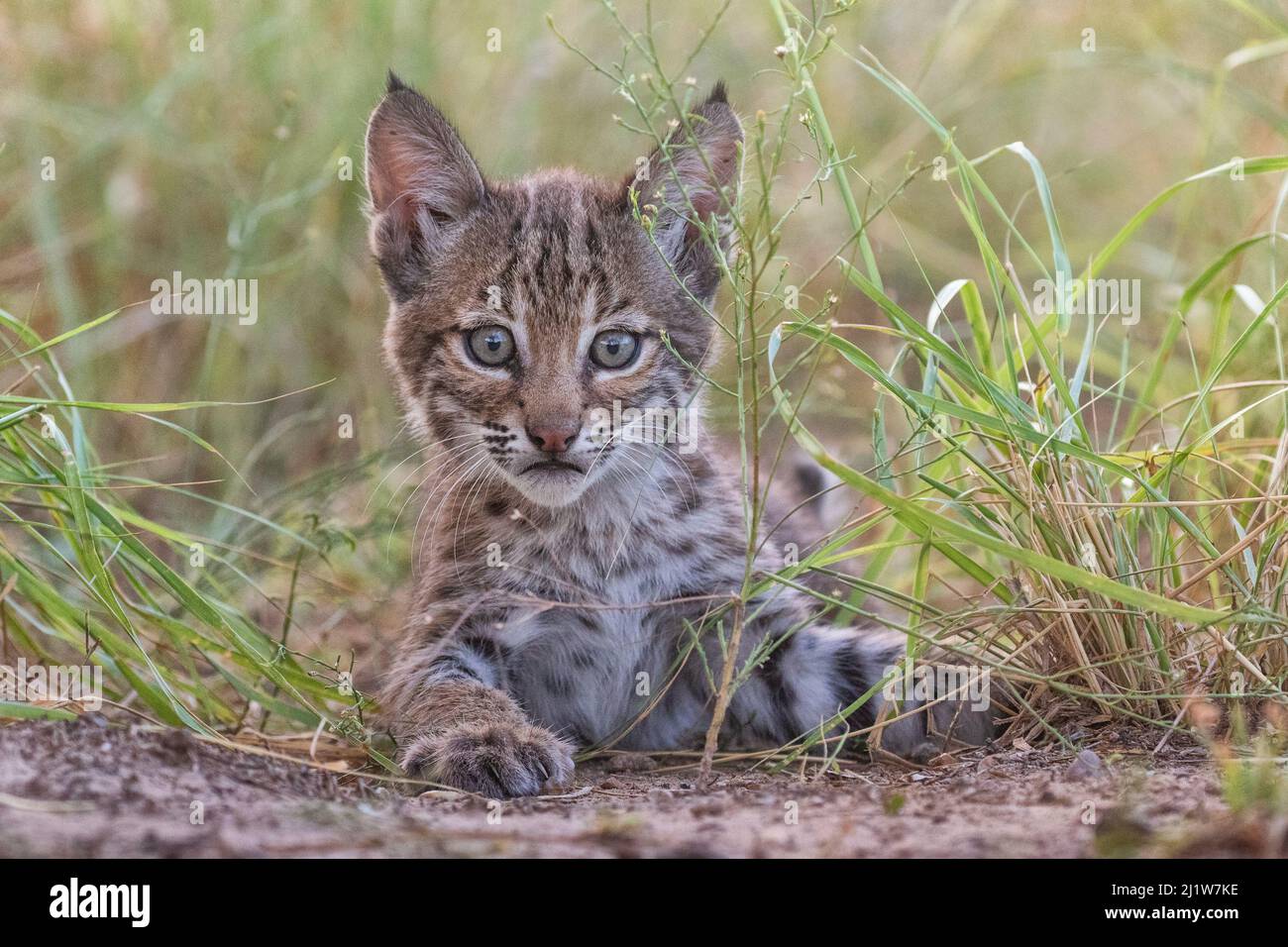 Portrait of a wild female Bobcat (Lynx rufus) kitten playing, Texas, USA. September. Stock Photohttps://www.alamy.com/image-license-details/?v=1https://www.alamy.com/portrait-of-a-wild-female-bobcat-lynx-rufus-kitten-playing-texas-usa-september-image465849426.html
Portrait of a wild female Bobcat (Lynx rufus) kitten playing, Texas, USA. September. Stock Photohttps://www.alamy.com/image-license-details/?v=1https://www.alamy.com/portrait-of-a-wild-female-bobcat-lynx-rufus-kitten-playing-texas-usa-september-image465849426.htmlRM2J1W7KE–Portrait of a wild female Bobcat (Lynx rufus) kitten playing, Texas, USA. September.
 Wild Bobcat (Lynx rufus) family of three cubs drinking water from bowl, with mother stretching . The mother chose to make her den underneath the house. Texas, USA, August. Taken with remote camera. Highly commended in the Urban Wildlife Category of the Wildlife Photographer of the Year Awards (WPOY) 2018. Stock Photohttps://www.alamy.com/image-license-details/?v=1https://www.alamy.com/wild-bobcat-lynx-rufus-family-of-three-cubs-drinking-water-from-bowl-with-mother-stretching-the-mother-chose-to-make-her-den-underneath-the-house-texas-usa-august-taken-with-remote-camera-highly-commended-in-the-urban-wildlife-category-of-the-wildlife-photographer-of-the-year-awards-wpoy-2018-image338999548.html
Wild Bobcat (Lynx rufus) family of three cubs drinking water from bowl, with mother stretching . The mother chose to make her den underneath the house. Texas, USA, August. Taken with remote camera. Highly commended in the Urban Wildlife Category of the Wildlife Photographer of the Year Awards (WPOY) 2018. Stock Photohttps://www.alamy.com/image-license-details/?v=1https://www.alamy.com/wild-bobcat-lynx-rufus-family-of-three-cubs-drinking-water-from-bowl-with-mother-stretching-the-mother-chose-to-make-her-den-underneath-the-house-texas-usa-august-taken-with-remote-camera-highly-commended-in-the-urban-wildlife-category-of-the-wildlife-photographer-of-the-year-awards-wpoy-2018-image338999548.htmlRM2AKENAM–Wild Bobcat (Lynx rufus) family of three cubs drinking water from bowl, with mother stretching . The mother chose to make her den underneath the house. Texas, USA, August. Taken with remote camera. Highly commended in the Urban Wildlife Category of the Wildlife Photographer of the Year Awards (WPOY) 2018.
 Kirtland's warbler (Setophaga kirtlandii) sitting on Jack Pine carrying food for her young, Michigan, USA, July. Stock Photohttps://www.alamy.com/image-license-details/?v=1https://www.alamy.com/kirtland39s-warbler-setophaga-kirtlandii-sitting-on-jack-pine-carrying-food-for-her-young-michigan-usa-july-image612157582.html
Kirtland's warbler (Setophaga kirtlandii) sitting on Jack Pine carrying food for her young, Michigan, USA, July. Stock Photohttps://www.alamy.com/image-license-details/?v=1https://www.alamy.com/kirtland39s-warbler-setophaga-kirtlandii-sitting-on-jack-pine-carrying-food-for-her-young-michigan-usa-july-image612157582.htmlRM2XFX56P–Kirtland's warbler (Setophaga kirtlandii) sitting on Jack Pine carrying food for her young, Michigan, USA, July.
 Kirtland's warbler (Setophaga kirtlandii) sitting in tree in Jack Pine habitat. Michigan, USA. July. Stock Photohttps://www.alamy.com/image-license-details/?v=1https://www.alamy.com/kirtland39s-warbler-setophaga-kirtlandii-sitting-in-tree-in-jack-pine-habitat-michigan-usa-july-image612157587.html
Kirtland's warbler (Setophaga kirtlandii) sitting in tree in Jack Pine habitat. Michigan, USA. July. Stock Photohttps://www.alamy.com/image-license-details/?v=1https://www.alamy.com/kirtland39s-warbler-setophaga-kirtlandii-sitting-in-tree-in-jack-pine-habitat-michigan-usa-july-image612157587.htmlRM2XFX56Y–Kirtland's warbler (Setophaga kirtlandii) sitting in tree in Jack Pine habitat. Michigan, USA. July.
 Kirtland's warbler (Setophaga kirtlandii) female in Jack pine habitat bringing food to her nest, Michigan, USA, July. Stock Photohttps://www.alamy.com/image-license-details/?v=1https://www.alamy.com/kirtland39s-warbler-setophaga-kirtlandii-female-in-jack-pine-habitat-bringing-food-to-her-nest-michigan-usa-july-image612157581.html
Kirtland's warbler (Setophaga kirtlandii) female in Jack pine habitat bringing food to her nest, Michigan, USA, July. Stock Photohttps://www.alamy.com/image-license-details/?v=1https://www.alamy.com/kirtland39s-warbler-setophaga-kirtlandii-female-in-jack-pine-habitat-bringing-food-to-her-nest-michigan-usa-july-image612157581.htmlRM2XFX56N–Kirtland's warbler (Setophaga kirtlandii) female in Jack pine habitat bringing food to her nest, Michigan, USA, July.
 Biologist Nathan Cooper holding male Kirtland's warbler (Setophaga kirtlandii) before replacing previous nano tag with a new one. Michigan, USA. July 2017. Stock Photohttps://www.alamy.com/image-license-details/?v=1https://www.alamy.com/biologist-nathan-cooper-holding-male-kirtland39s-warbler-setophaga-kirtlandii-before-replacing-previous-nano-tag-with-a-new-one-michigan-usa-july-2017-image612157506.html
Biologist Nathan Cooper holding male Kirtland's warbler (Setophaga kirtlandii) before replacing previous nano tag with a new one. Michigan, USA. July 2017. Stock Photohttps://www.alamy.com/image-license-details/?v=1https://www.alamy.com/biologist-nathan-cooper-holding-male-kirtland39s-warbler-setophaga-kirtlandii-before-replacing-previous-nano-tag-with-a-new-one-michigan-usa-july-2017-image612157506.htmlRM2XFX542–Biologist Nathan Cooper holding male Kirtland's warbler (Setophaga kirtlandii) before replacing previous nano tag with a new one. Michigan, USA. July 2017.
 Portrait of female ecoguard / ranger, with colleagues in Salonga National Park, Democratic Republic of Congo. May 2017. There are 16 women who work as Stock Photohttps://www.alamy.com/image-license-details/?v=1https://www.alamy.com/portrait-of-female-ecoguard-ranger-with-colleagues-in-salonga-national-park-democratic-republic-of-congo-may-2017-there-are-16-women-who-work-as-image465847850.html
Portrait of female ecoguard / ranger, with colleagues in Salonga National Park, Democratic Republic of Congo. May 2017. There are 16 women who work as Stock Photohttps://www.alamy.com/image-license-details/?v=1https://www.alamy.com/portrait-of-female-ecoguard-ranger-with-colleagues-in-salonga-national-park-democratic-republic-of-congo-may-2017-there-are-16-women-who-work-as-image465847850.htmlRM2J1W5K6–Portrait of female ecoguard / ranger, with colleagues in Salonga National Park, Democratic Republic of Congo. May 2017. There are 16 women who work as
 Portrait of female ecoguard / ranger Salonga National Park, Democratic Republic of Congo. May 2017. There are 16 women who work as Ecoguards protecti Stock Photohttps://www.alamy.com/image-license-details/?v=1https://www.alamy.com/portrait-of-female-ecoguard-ranger-salonga-national-park-democratic-republic-of-congo-may-2017-there-are-16-women-who-work-as-ecoguards-protecti-image465847833.html
Portrait of female ecoguard / ranger Salonga National Park, Democratic Republic of Congo. May 2017. There are 16 women who work as Ecoguards protecti Stock Photohttps://www.alamy.com/image-license-details/?v=1https://www.alamy.com/portrait-of-female-ecoguard-ranger-salonga-national-park-democratic-republic-of-congo-may-2017-there-are-16-women-who-work-as-ecoguards-protecti-image465847833.htmlRM2J1W5JH–Portrait of female ecoguard / ranger Salonga National Park, Democratic Republic of Congo. May 2017. There are 16 women who work as Ecoguards protecti
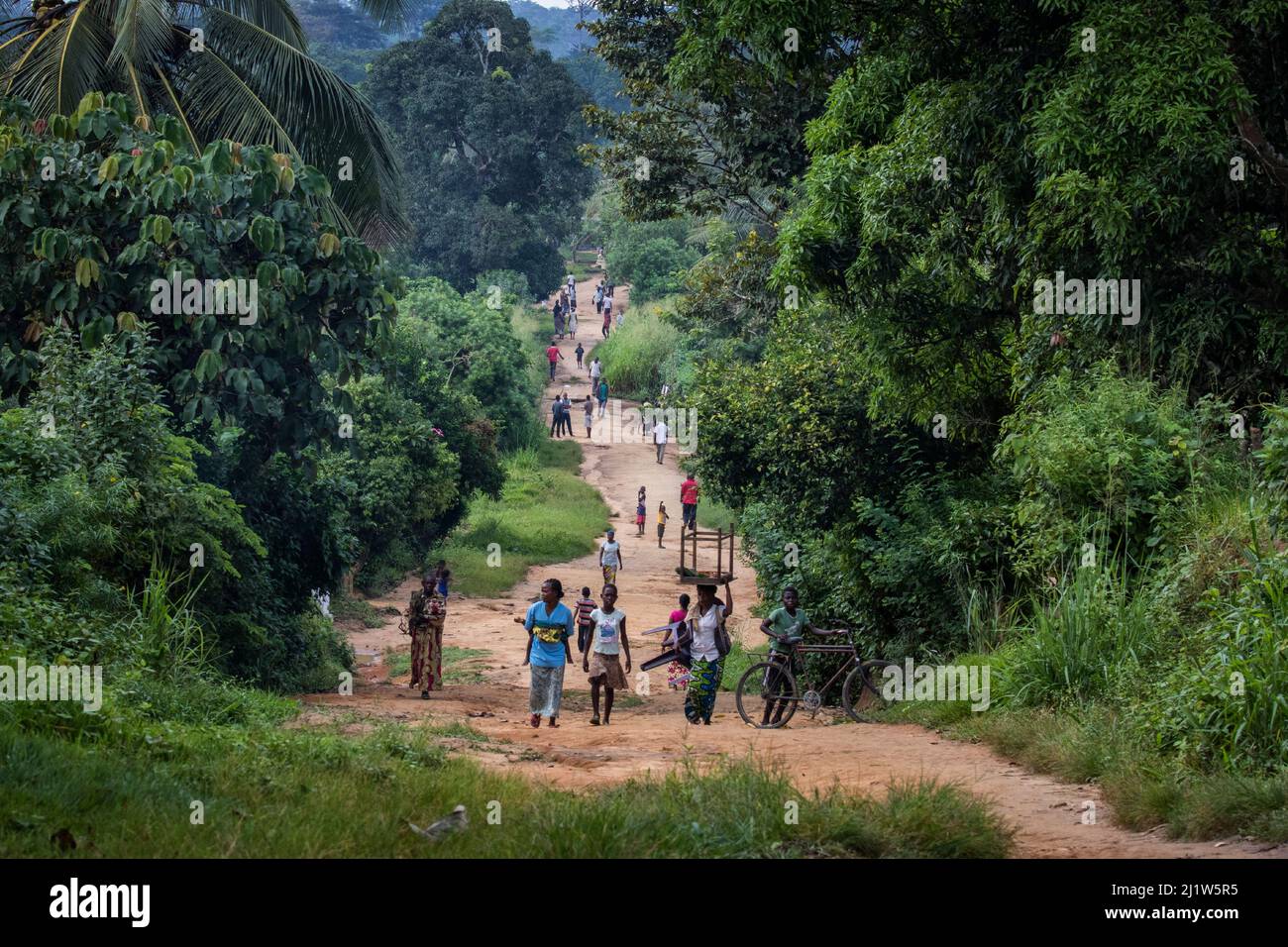 Group of people on busy road, Democratic Republic of Congo. May 2017. Stock Photohttps://www.alamy.com/image-license-details/?v=1https://www.alamy.com/group-of-people-on-busy-road-democratic-republic-of-congo-may-2017-image465847961.html
Group of people on busy road, Democratic Republic of Congo. May 2017. Stock Photohttps://www.alamy.com/image-license-details/?v=1https://www.alamy.com/group-of-people-on-busy-road-democratic-republic-of-congo-may-2017-image465847961.htmlRM2J1W5R5–Group of people on busy road, Democratic Republic of Congo. May 2017.
 Congolese woman holding hand made palm oil soap, made by local women to sell at the market. Oshwe, Democratic Republic of Congo. May 2017. Stock Photohttps://www.alamy.com/image-license-details/?v=1https://www.alamy.com/congolese-woman-holding-hand-made-palm-oil-soap-made-by-local-women-to-sell-at-the-market-oshwe-democratic-republic-of-congo-may-2017-image465847813.html
Congolese woman holding hand made palm oil soap, made by local women to sell at the market. Oshwe, Democratic Republic of Congo. May 2017. Stock Photohttps://www.alamy.com/image-license-details/?v=1https://www.alamy.com/congolese-woman-holding-hand-made-palm-oil-soap-made-by-local-women-to-sell-at-the-market-oshwe-democratic-republic-of-congo-may-2017-image465847813.htmlRM2J1W5HW–Congolese woman holding hand made palm oil soap, made by local women to sell at the market. Oshwe, Democratic Republic of Congo. May 2017.
 Bonobo (Pan paniscus) in tree, Democratic Republic of Congo. Part of a family group monitored by Projet PICBOU, community-led ecotourism and bonobo co Stock Photohttps://www.alamy.com/image-license-details/?v=1https://www.alamy.com/bonobo-pan-paniscus-in-tree-democratic-republic-of-congo-part-of-a-family-group-monitored-by-projet-picbou-community-led-ecotourism-and-bonobo-co-image465847953.html
Bonobo (Pan paniscus) in tree, Democratic Republic of Congo. Part of a family group monitored by Projet PICBOU, community-led ecotourism and bonobo co Stock Photohttps://www.alamy.com/image-license-details/?v=1https://www.alamy.com/bonobo-pan-paniscus-in-tree-democratic-republic-of-congo-part-of-a-family-group-monitored-by-projet-picbou-community-led-ecotourism-and-bonobo-co-image465847953.htmlRM2J1W5PW–Bonobo (Pan paniscus) in tree, Democratic Republic of Congo. Part of a family group monitored by Projet PICBOU, community-led ecotourism and bonobo co
 Scientist Nathan Cooper writing down data after he weighs and measures a Kirtland's warbler (Setophaga kirtlandii) Cat Island, Bahamas, April 2017. Stock Photohttps://www.alamy.com/image-license-details/?v=1https://www.alamy.com/scientist-nathan-cooper-writing-down-data-after-he-weighs-and-measures-a-kirtland39s-warbler-setophaga-kirtlandii-cat-island-bahamas-april-2017-image612157500.html
Scientist Nathan Cooper writing down data after he weighs and measures a Kirtland's warbler (Setophaga kirtlandii) Cat Island, Bahamas, April 2017. Stock Photohttps://www.alamy.com/image-license-details/?v=1https://www.alamy.com/scientist-nathan-cooper-writing-down-data-after-he-weighs-and-measures-a-kirtland39s-warbler-setophaga-kirtlandii-cat-island-bahamas-april-2017-image612157500.htmlRM2XFX53T–Scientist Nathan Cooper writing down data after he weighs and measures a Kirtland's warbler (Setophaga kirtlandii) Cat Island, Bahamas, April 2017.
 Scientist Nathan Cooper at the Smithsonian Migratory Bird Center holding Kirtland's warbler (Setophaga kirtlandii) during tagging study. CAt Island, Bahamas. April 2017. Stock Photohttps://www.alamy.com/image-license-details/?v=1https://www.alamy.com/scientist-nathan-cooper-at-the-smithsonian-migratory-bird-center-holding-kirtland39s-warbler-setophaga-kirtlandii-during-tagging-study-cat-island-bahamas-april-2017-image612157412.html
Scientist Nathan Cooper at the Smithsonian Migratory Bird Center holding Kirtland's warbler (Setophaga kirtlandii) during tagging study. CAt Island, Bahamas. April 2017. Stock Photohttps://www.alamy.com/image-license-details/?v=1https://www.alamy.com/scientist-nathan-cooper-at-the-smithsonian-migratory-bird-center-holding-kirtland39s-warbler-setophaga-kirtlandii-during-tagging-study-cat-island-bahamas-april-2017-image612157412.htmlRM2XFX50M–Scientist Nathan Cooper at the Smithsonian Migratory Bird Center holding Kirtland's warbler (Setophaga kirtlandii) during tagging study. CAt Island, Bahamas. April 2017.
 Landscape of beach on Cat Island, Bahamas, April 2017. Stock Photohttps://www.alamy.com/image-license-details/?v=1https://www.alamy.com/landscape-of-beach-on-cat-island-bahamas-april-2017-image612157407.html
Landscape of beach on Cat Island, Bahamas, April 2017. Stock Photohttps://www.alamy.com/image-license-details/?v=1https://www.alamy.com/landscape-of-beach-on-cat-island-bahamas-april-2017-image612157407.htmlRM2XFX50F–Landscape of beach on Cat Island, Bahamas, April 2017.
 Smooth-billed ani (Crotophaga ani) Cat Island, Bahamas Stock Photohttps://www.alamy.com/image-license-details/?v=1https://www.alamy.com/smooth-billed-ani-crotophaga-ani-cat-island-bahamas-image612157682.html
Smooth-billed ani (Crotophaga ani) Cat Island, Bahamas Stock Photohttps://www.alamy.com/image-license-details/?v=1https://www.alamy.com/smooth-billed-ani-crotophaga-ani-cat-island-bahamas-image612157682.htmlRM2XFX5AA–Smooth-billed ani (Crotophaga ani) Cat Island, Bahamas
 Eastern yellow-bellied racer (Coluber constrictor flaviventris), eating a checkered garter snake (Thamnophis marcianus). Texas, USA, July. Stock Photohttps://www.alamy.com/image-license-details/?v=1https://www.alamy.com/eastern-yellow-bellied-racer-coluber-constrictor-flaviventris-eating-a-checkered-garter-snake-thamnophis-marcianus-texas-usa-july-image612093893.html
Eastern yellow-bellied racer (Coluber constrictor flaviventris), eating a checkered garter snake (Thamnophis marcianus). Texas, USA, July. Stock Photohttps://www.alamy.com/image-license-details/?v=1https://www.alamy.com/eastern-yellow-bellied-racer-coluber-constrictor-flaviventris-eating-a-checkered-garter-snake-thamnophis-marcianus-texas-usa-july-image612093893.htmlRM2XFR805–Eastern yellow-bellied racer (Coluber constrictor flaviventris), eating a checkered garter snake (Thamnophis marcianus). Texas, USA, July.
 Black-tailed jackrabbit (Lepus californicus) sticking tongue out, Texas, USA, July. Stock Photohttps://www.alamy.com/image-license-details/?v=1https://www.alamy.com/black-tailed-jackrabbit-lepus-californicus-sticking-tongue-out-texas-usa-july-image612093916.html
Black-tailed jackrabbit (Lepus californicus) sticking tongue out, Texas, USA, July. Stock Photohttps://www.alamy.com/image-license-details/?v=1https://www.alamy.com/black-tailed-jackrabbit-lepus-californicus-sticking-tongue-out-texas-usa-july-image612093916.htmlRM2XFR810–Black-tailed jackrabbit (Lepus californicus) sticking tongue out, Texas, USA, July.
 Mexican free-tailed bat (Tadarida brasiliensis) on a glove. Bracken Cave Preserve, San Antonio, Texas, USA, July. Stock Photohttps://www.alamy.com/image-license-details/?v=1https://www.alamy.com/mexican-free-tailed-bat-tadarida-brasiliensis-on-a-glove-bracken-cave-preserve-san-antonio-texas-usa-july-image612093977.html
Mexican free-tailed bat (Tadarida brasiliensis) on a glove. Bracken Cave Preserve, San Antonio, Texas, USA, July. Stock Photohttps://www.alamy.com/image-license-details/?v=1https://www.alamy.com/mexican-free-tailed-bat-tadarida-brasiliensis-on-a-glove-bracken-cave-preserve-san-antonio-texas-usa-july-image612093977.htmlRM2XFR835–Mexican free-tailed bat (Tadarida brasiliensis) on a glove. Bracken Cave Preserve, San Antonio, Texas, USA, July.
 Children learning about Mexican Free-tailed bats (Tadarida brasiliensis), and make 'bat masks' while waiting for the bats to emerge at Bracken Cave. Bracken Cave Preserve, San Antonio, Texas, USA. July 2015. Bracken Cave is the world's largest bat maternity colony. Stock Photohttps://www.alamy.com/image-license-details/?v=1https://www.alamy.com/children-learning-about-mexican-free-tailed-bats-tadarida-brasiliensis-and-make-bat-masks-while-waiting-for-the-bats-to-emerge-at-bracken-cave-bracken-cave-preserve-san-antonio-texas-usa-july-2015-bracken-cave-is-the-worlds-largest-bat-maternity-colony-image612093914.html
Children learning about Mexican Free-tailed bats (Tadarida brasiliensis), and make 'bat masks' while waiting for the bats to emerge at Bracken Cave. Bracken Cave Preserve, San Antonio, Texas, USA. July 2015. Bracken Cave is the world's largest bat maternity colony. Stock Photohttps://www.alamy.com/image-license-details/?v=1https://www.alamy.com/children-learning-about-mexican-free-tailed-bats-tadarida-brasiliensis-and-make-bat-masks-while-waiting-for-the-bats-to-emerge-at-bracken-cave-bracken-cave-preserve-san-antonio-texas-usa-july-2015-bracken-cave-is-the-worlds-largest-bat-maternity-colony-image612093914.htmlRM2XFR80X–Children learning about Mexican Free-tailed bats (Tadarida brasiliensis), and make 'bat masks' while waiting for the bats to emerge at Bracken Cave. Bracken Cave Preserve, San Antonio, Texas, USA. July 2015. Bracken Cave is the world's largest bat maternity colony.
 Tourists viewing Mexican free-tailed bats (Tadarida brasiliensis) leaving maternity colony at night to feed. This viewing is organized by Bat Conservation International. Bracken Cave, San Antonio, Texas, USA, June. Bracken Cave is the world's largest bat maternity colony. Stock Photohttps://www.alamy.com/image-license-details/?v=1https://www.alamy.com/tourists-viewing-mexican-free-tailed-bats-tadarida-brasiliensis-leaving-maternity-colony-at-night-to-feed-this-viewing-is-organized-by-bat-conservation-international-bracken-cave-san-antonio-texas-usa-june-bracken-cave-is-the-worlds-largest-bat-maternity-colony-image612093899.html
Tourists viewing Mexican free-tailed bats (Tadarida brasiliensis) leaving maternity colony at night to feed. This viewing is organized by Bat Conservation International. Bracken Cave, San Antonio, Texas, USA, June. Bracken Cave is the world's largest bat maternity colony. Stock Photohttps://www.alamy.com/image-license-details/?v=1https://www.alamy.com/tourists-viewing-mexican-free-tailed-bats-tadarida-brasiliensis-leaving-maternity-colony-at-night-to-feed-this-viewing-is-organized-by-bat-conservation-international-bracken-cave-san-antonio-texas-usa-june-bracken-cave-is-the-worlds-largest-bat-maternity-colony-image612093899.htmlRM2XFR80B–Tourists viewing Mexican free-tailed bats (Tadarida brasiliensis) leaving maternity colony at night to feed. This viewing is organized by Bat Conservation International. Bracken Cave, San Antonio, Texas, USA, June. Bracken Cave is the world's largest bat maternity colony.
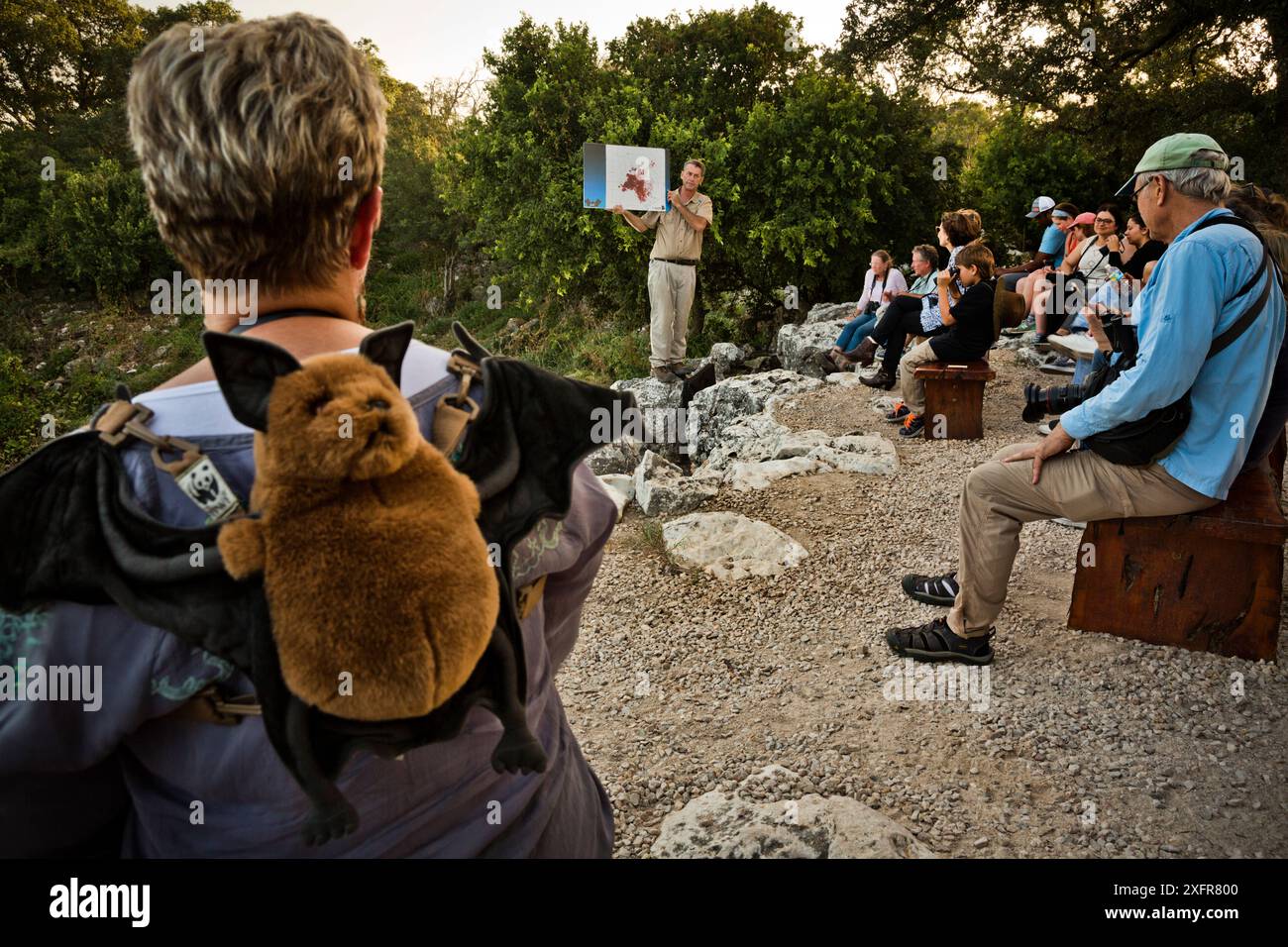 Visitors to Bracken Cave listening as Fran Hutchens, Bat Conservation International's director of Bracken Cave Preserve, gives educational information to visitors about the lives and existence of the Mexican free-tailed bat. Bracken Cave, San Antonio, Texas, USA, July 2015. Stock Photohttps://www.alamy.com/image-license-details/?v=1https://www.alamy.com/visitors-to-bracken-cave-listening-as-fran-hutchens-bat-conservation-internationals-director-of-bracken-cave-preserve-gives-educational-information-to-visitors-about-the-lives-and-existence-of-the-mexican-free-tailed-bat-bracken-cave-san-antonio-texas-usa-july-2015-image612093888.html
Visitors to Bracken Cave listening as Fran Hutchens, Bat Conservation International's director of Bracken Cave Preserve, gives educational information to visitors about the lives and existence of the Mexican free-tailed bat. Bracken Cave, San Antonio, Texas, USA, July 2015. Stock Photohttps://www.alamy.com/image-license-details/?v=1https://www.alamy.com/visitors-to-bracken-cave-listening-as-fran-hutchens-bat-conservation-internationals-director-of-bracken-cave-preserve-gives-educational-information-to-visitors-about-the-lives-and-existence-of-the-mexican-free-tailed-bat-bracken-cave-san-antonio-texas-usa-july-2015-image612093888.htmlRM2XFR800–Visitors to Bracken Cave listening as Fran Hutchens, Bat Conservation International's director of Bracken Cave Preserve, gives educational information to visitors about the lives and existence of the Mexican free-tailed bat. Bracken Cave, San Antonio, Texas, USA, July 2015.
 Park ranger Niki Lake poses as 'Batty the Clown' in San Antonio in San Antonio where a bachelor colony of Mexican free-tailed bats (Tadarida brasiliensis) live under the bridge. San Antonio, Texas, USA, July 2015. Stock Photohttps://www.alamy.com/image-license-details/?v=1https://www.alamy.com/park-ranger-niki-lake-poses-as-batty-the-clown-in-san-antonio-in-san-antonio-where-a-bachelor-colony-of-mexican-free-tailed-bats-tadarida-brasiliensis-live-under-the-bridge-san-antonio-texas-usa-july-2015-image612093894.html
Park ranger Niki Lake poses as 'Batty the Clown' in San Antonio in San Antonio where a bachelor colony of Mexican free-tailed bats (Tadarida brasiliensis) live under the bridge. San Antonio, Texas, USA, July 2015. Stock Photohttps://www.alamy.com/image-license-details/?v=1https://www.alamy.com/park-ranger-niki-lake-poses-as-batty-the-clown-in-san-antonio-in-san-antonio-where-a-bachelor-colony-of-mexican-free-tailed-bats-tadarida-brasiliensis-live-under-the-bridge-san-antonio-texas-usa-july-2015-image612093894.htmlRM2XFR806–Park ranger Niki Lake poses as 'Batty the Clown' in San Antonio in San Antonio where a bachelor colony of Mexican free-tailed bats (Tadarida brasiliensis) live under the bridge. San Antonio, Texas, USA, July 2015.
 Park ranger Niki Lake poses as 'Batty the Clown' alongside her friend 'Ellie the Moth' in San Antonio where a bachelor colony of Mexican free-tailed bats (Tadarida brasiliensis) live under the bridge. San Antonio, Texas, USA, July 2015. Stock Photohttps://www.alamy.com/image-license-details/?v=1https://www.alamy.com/park-ranger-niki-lake-poses-as-batty-the-clown-alongside-her-friend-ellie-the-moth-in-san-antonio-where-a-bachelor-colony-of-mexican-free-tailed-bats-tadarida-brasiliensis-live-under-the-bridge-san-antonio-texas-usa-july-2015-image612093906.html
Park ranger Niki Lake poses as 'Batty the Clown' alongside her friend 'Ellie the Moth' in San Antonio where a bachelor colony of Mexican free-tailed bats (Tadarida brasiliensis) live under the bridge. San Antonio, Texas, USA, July 2015. Stock Photohttps://www.alamy.com/image-license-details/?v=1https://www.alamy.com/park-ranger-niki-lake-poses-as-batty-the-clown-alongside-her-friend-ellie-the-moth-in-san-antonio-where-a-bachelor-colony-of-mexican-free-tailed-bats-tadarida-brasiliensis-live-under-the-bridge-san-antonio-texas-usa-july-2015-image612093906.htmlRM2XFR80J–Park ranger Niki Lake poses as 'Batty the Clown' alongside her friend 'Ellie the Moth' in San Antonio where a bachelor colony of Mexican free-tailed bats (Tadarida brasiliensis) live under the bridge. San Antonio, Texas, USA, July 2015.
 African wild dogs (Lycaon pictus) watching an African elephant (Loxodonta africana) bathe in mud. Zimbabwe. Stock Photohttps://www.alamy.com/image-license-details/?v=1https://www.alamy.com/african-wild-dogs-lycaon-pictus-watching-an-african-elephant-loxodonta-africana-bathe-in-mud-zimbabwe-image612157216.html
African wild dogs (Lycaon pictus) watching an African elephant (Loxodonta africana) bathe in mud. Zimbabwe. Stock Photohttps://www.alamy.com/image-license-details/?v=1https://www.alamy.com/african-wild-dogs-lycaon-pictus-watching-an-african-elephant-loxodonta-africana-bathe-in-mud-zimbabwe-image612157216.htmlRM2XFX4NM–African wild dogs (Lycaon pictus) watching an African elephant (Loxodonta africana) bathe in mud. Zimbabwe.
 African wild dog (lycaon pictus) watching as two of the pack's pups play. Malilangwe Wildlife Reserve, Zimbabwe. Stock Photohttps://www.alamy.com/image-license-details/?v=1https://www.alamy.com/african-wild-dog-lycaon-pictus-watching-as-two-of-the-packs-pups-play-malilangwe-wildlife-reserve-zimbabwe-image612157324.html
African wild dog (lycaon pictus) watching as two of the pack's pups play. Malilangwe Wildlife Reserve, Zimbabwe. Stock Photohttps://www.alamy.com/image-license-details/?v=1https://www.alamy.com/african-wild-dog-lycaon-pictus-watching-as-two-of-the-packs-pups-play-malilangwe-wildlife-reserve-zimbabwe-image612157324.htmlRM2XFX4WG–African wild dog (lycaon pictus) watching as two of the pack's pups play. Malilangwe Wildlife Reserve, Zimbabwe.
 African wild dog (lycaon pictus) plays with one of the pack's pups. Malilangwe Wildlife Reserve, Zimbabwe. Stock Photohttps://www.alamy.com/image-license-details/?v=1https://www.alamy.com/african-wild-dog-lycaon-pictus-plays-with-one-of-the-packs-pups-malilangwe-wildlife-reserve-zimbabwe-image612157217.html
African wild dog (lycaon pictus) plays with one of the pack's pups. Malilangwe Wildlife Reserve, Zimbabwe. Stock Photohttps://www.alamy.com/image-license-details/?v=1https://www.alamy.com/african-wild-dog-lycaon-pictus-plays-with-one-of-the-packs-pups-malilangwe-wildlife-reserve-zimbabwe-image612157217.htmlRM2XFX4NN–African wild dog (lycaon pictus) plays with one of the pack's pups. Malilangwe Wildlife Reserve, Zimbabwe.
 African wild dog (lycaon pictus) pups play before dark, walking in formation like the adults do. Malilangwe Wildlife Reserve, Zimbabwe. Stock Photohttps://www.alamy.com/image-license-details/?v=1https://www.alamy.com/african-wild-dog-lycaon-pictus-pups-play-before-dark-walking-in-formation-like-the-adults-do-malilangwe-wildlife-reserve-zimbabwe-image612157322.html
African wild dog (lycaon pictus) pups play before dark, walking in formation like the adults do. Malilangwe Wildlife Reserve, Zimbabwe. Stock Photohttps://www.alamy.com/image-license-details/?v=1https://www.alamy.com/african-wild-dog-lycaon-pictus-pups-play-before-dark-walking-in-formation-like-the-adults-do-malilangwe-wildlife-reserve-zimbabwe-image612157322.htmlRM2XFX4WE–African wild dog (lycaon pictus) pups play before dark, walking in formation like the adults do. Malilangwe Wildlife Reserve, Zimbabwe.
 African wild dog pups (Lycaon Pictus) looking at the camera. Zimbabwe. Stock Photohttps://www.alamy.com/image-license-details/?v=1https://www.alamy.com/african-wild-dog-pups-lycaon-pictus-looking-at-the-camera-zimbabwe-image612157231.html
African wild dog pups (Lycaon Pictus) looking at the camera. Zimbabwe. Stock Photohttps://www.alamy.com/image-license-details/?v=1https://www.alamy.com/african-wild-dog-pups-lycaon-pictus-looking-at-the-camera-zimbabwe-image612157231.htmlRM2XFX4P7–African wild dog pups (Lycaon Pictus) looking at the camera. Zimbabwe.
 Bee hummingbird (Mellisuga helenae) male, the world's smallest bird, endemic to Cuba. Cienaga de Zapata National Park, Cuba Stock Photohttps://www.alamy.com/image-license-details/?v=1https://www.alamy.com/bee-hummingbird-mellisuga-helenae-male-the-worlds-smallest-bird-endemic-to-cuba-cienaga-de-zapata-national-park-cuba-image612135128.html
Bee hummingbird (Mellisuga helenae) male, the world's smallest bird, endemic to Cuba. Cienaga de Zapata National Park, Cuba Stock Photohttps://www.alamy.com/image-license-details/?v=1https://www.alamy.com/bee-hummingbird-mellisuga-helenae-male-the-worlds-smallest-bird-endemic-to-cuba-cienaga-de-zapata-national-park-cuba-image612135128.htmlRM2XFW4GT–Bee hummingbird (Mellisuga helenae) male, the world's smallest bird, endemic to Cuba. Cienaga de Zapata National Park, Cuba
 Bee hummingbird (Mellisuga helenae) male the world's smallest bird, endemic to Cuba. Cienaga de Zapata National Park, Cuba Stock Photohttps://www.alamy.com/image-license-details/?v=1https://www.alamy.com/bee-hummingbird-mellisuga-helenae-male-the-worlds-smallest-bird-endemic-to-cuba-cienaga-de-zapata-national-park-cuba-image612135136.html
Bee hummingbird (Mellisuga helenae) male the world's smallest bird, endemic to Cuba. Cienaga de Zapata National Park, Cuba Stock Photohttps://www.alamy.com/image-license-details/?v=1https://www.alamy.com/bee-hummingbird-mellisuga-helenae-male-the-worlds-smallest-bird-endemic-to-cuba-cienaga-de-zapata-national-park-cuba-image612135136.htmlRM2XFW4H4–Bee hummingbird (Mellisuga helenae) male the world's smallest bird, endemic to Cuba. Cienaga de Zapata National Park, Cuba
 Hermit thrush (Catharus guttatus) wearing a barely visible nano-transmitter. Block island, Rhode Island, USA. Stock Photohttps://www.alamy.com/image-license-details/?v=1https://www.alamy.com/hermit-thrush-catharus-guttatus-wearing-a-barely-visible-nano-transmitter-block-island-rhode-island-usa-image612157723.html
Hermit thrush (Catharus guttatus) wearing a barely visible nano-transmitter. Block island, Rhode Island, USA. Stock Photohttps://www.alamy.com/image-license-details/?v=1https://www.alamy.com/hermit-thrush-catharus-guttatus-wearing-a-barely-visible-nano-transmitter-block-island-rhode-island-usa-image612157723.htmlRM2XFX5BR–Hermit thrush (Catharus guttatus) wearing a barely visible nano-transmitter. Block island, Rhode Island, USA.
 Portrait of a Myrtle warbler (Dendroica coronata coronata) with white background, Block island, Rhode Island, USA. Bird caught during scientific research. Stock Photohttps://www.alamy.com/image-license-details/?v=1https://www.alamy.com/portrait-of-a-myrtle-warbler-dendroica-coronata-coronata-with-white-background-block-island-rhode-island-usa-bird-caught-during-scientific-research-image612157719.html
Portrait of a Myrtle warbler (Dendroica coronata coronata) with white background, Block island, Rhode Island, USA. Bird caught during scientific research. Stock Photohttps://www.alamy.com/image-license-details/?v=1https://www.alamy.com/portrait-of-a-myrtle-warbler-dendroica-coronata-coronata-with-white-background-block-island-rhode-island-usa-bird-caught-during-scientific-research-image612157719.htmlRM2XFX5BK–Portrait of a Myrtle warbler (Dendroica coronata coronata) with white background, Block island, Rhode Island, USA. Bird caught during scientific research.
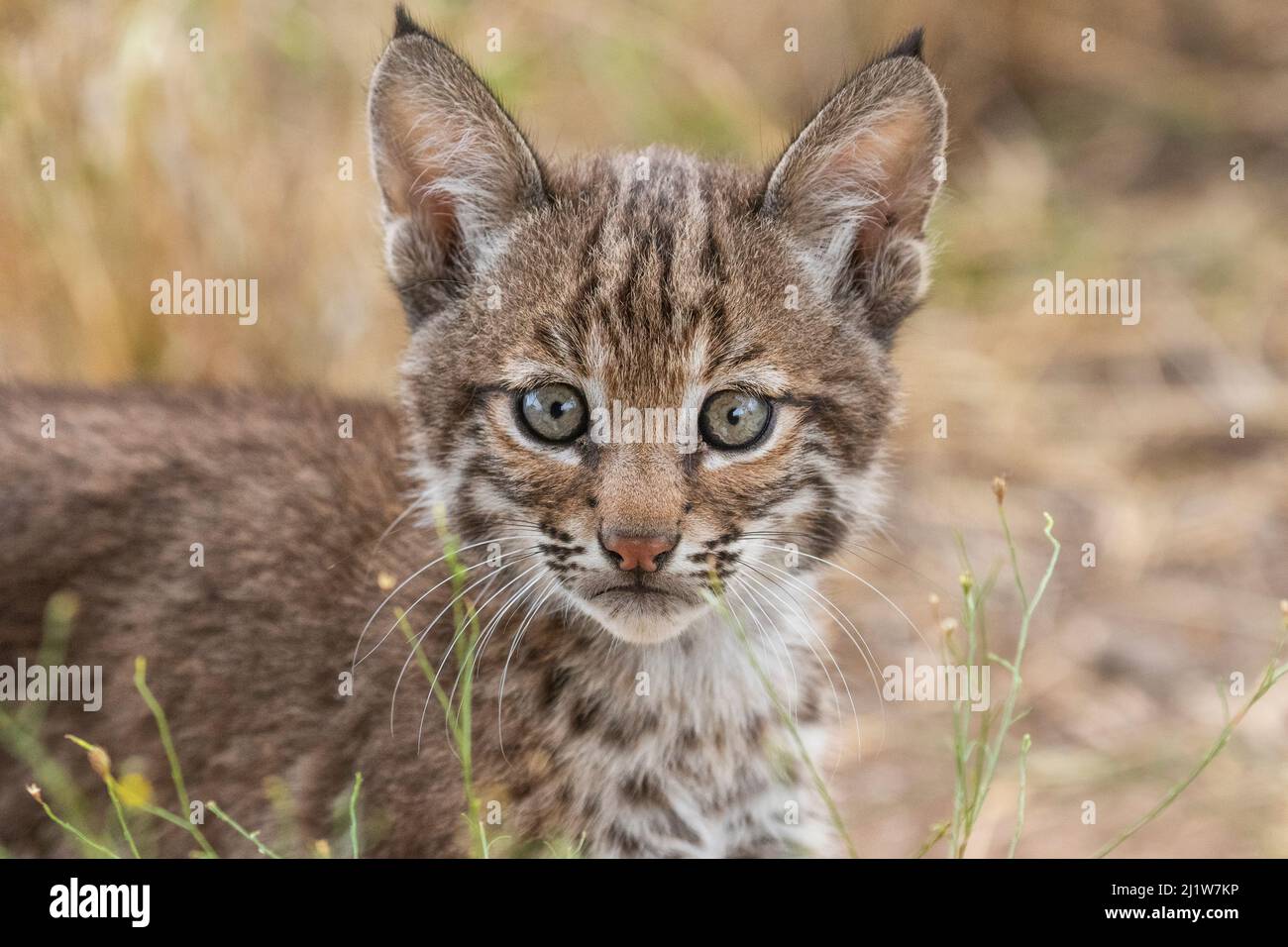 Portrait of a wild female Bobcat (Lynx rufus) kitten, Texas, USA. September. Stock Photohttps://www.alamy.com/image-license-details/?v=1https://www.alamy.com/portrait-of-a-wild-female-bobcat-lynx-rufus-kitten-texas-usa-september-image465849434.html
Portrait of a wild female Bobcat (Lynx rufus) kitten, Texas, USA. September. Stock Photohttps://www.alamy.com/image-license-details/?v=1https://www.alamy.com/portrait-of-a-wild-female-bobcat-lynx-rufus-kitten-texas-usa-september-image465849434.htmlRM2J1W7KP–Portrait of a wild female Bobcat (Lynx rufus) kitten, Texas, USA. September.
 Portrait of a wild Bobcat (Lynx rufus) kitten in a tree, Texas, USA. September. Stock Photohttps://www.alamy.com/image-license-details/?v=1https://www.alamy.com/portrait-of-a-wild-bobcat-lynx-rufus-kitten-in-a-tree-texas-usa-september-image465849431.html
Portrait of a wild Bobcat (Lynx rufus) kitten in a tree, Texas, USA. September. Stock Photohttps://www.alamy.com/image-license-details/?v=1https://www.alamy.com/portrait-of-a-wild-bobcat-lynx-rufus-kitten-in-a-tree-texas-usa-september-image465849431.htmlRM2J1W7KK–Portrait of a wild Bobcat (Lynx rufus) kitten in a tree, Texas, USA. September.
 Cuban parakeets (Psittacara euops) preening each other, Bermejas, Cuba. Endemic. Stock Photohttps://www.alamy.com/image-license-details/?v=1https://www.alamy.com/cuban-parakeets-psittacara-euops-preening-each-other-bermejas-cuba-endemic-image342309926.html
Cuban parakeets (Psittacara euops) preening each other, Bermejas, Cuba. Endemic. Stock Photohttps://www.alamy.com/image-license-details/?v=1https://www.alamy.com/cuban-parakeets-psittacara-euops-preening-each-other-bermejas-cuba-endemic-image342309926.htmlRM2ATWFPE–Cuban parakeets (Psittacara euops) preening each other, Bermejas, Cuba. Endemic.
 Kirtland's warbler (Setophaga kirtlandii) nano tagged male sitting in Jack pine, Michigan, USA, July. Stock Photohttps://www.alamy.com/image-license-details/?v=1https://www.alamy.com/kirtland39s-warbler-setophaga-kirtlandii-nano-tagged-male-sitting-in-jack-pine-michigan-usa-july-image612157574.html
Kirtland's warbler (Setophaga kirtlandii) nano tagged male sitting in Jack pine, Michigan, USA, July. Stock Photohttps://www.alamy.com/image-license-details/?v=1https://www.alamy.com/kirtland39s-warbler-setophaga-kirtlandii-nano-tagged-male-sitting-in-jack-pine-michigan-usa-july-image612157574.htmlRM2XFX56E–Kirtland's warbler (Setophaga kirtlandii) nano tagged male sitting in Jack pine, Michigan, USA, July.
 Biologist Nathan Cooper taking measurements from male Kirtland's warbler (Setophaga kirtlandii) before replacing previous nano tag with a new one.Michigan, USA. July 2017. Stock Photohttps://www.alamy.com/image-license-details/?v=1https://www.alamy.com/biologist-nathan-cooper-taking-measurements-from-male-kirtland39s-warbler-setophaga-kirtlandii-before-replacing-previous-nano-tag-with-a-new-onemichigan-usa-july-2017-image612157504.html
Biologist Nathan Cooper taking measurements from male Kirtland's warbler (Setophaga kirtlandii) before replacing previous nano tag with a new one.Michigan, USA. July 2017. Stock Photohttps://www.alamy.com/image-license-details/?v=1https://www.alamy.com/biologist-nathan-cooper-taking-measurements-from-male-kirtland39s-warbler-setophaga-kirtlandii-before-replacing-previous-nano-tag-with-a-new-onemichigan-usa-july-2017-image612157504.htmlRM2XFX540–Biologist Nathan Cooper taking measurements from male Kirtland's warbler (Setophaga kirtlandii) before replacing previous nano tag with a new one.Michigan, USA. July 2017.
 Portrait of female ecoguard / ranger, Salonga National Park, Democratic Republic of Congo. May 2017. There are 16 women who work as Ecoguards in Salon Stock Photohttps://www.alamy.com/image-license-details/?v=1https://www.alamy.com/portrait-of-female-ecoguard-ranger-salonga-national-park-democratic-republic-of-congo-may-2017-there-are-16-women-who-work-as-ecoguards-in-salon-image465847894.html
Portrait of female ecoguard / ranger, Salonga National Park, Democratic Republic of Congo. May 2017. There are 16 women who work as Ecoguards in Salon Stock Photohttps://www.alamy.com/image-license-details/?v=1https://www.alamy.com/portrait-of-female-ecoguard-ranger-salonga-national-park-democratic-republic-of-congo-may-2017-there-are-16-women-who-work-as-ecoguards-in-salon-image465847894.htmlRM2J1W5MP–Portrait of female ecoguard / ranger, Salonga National Park, Democratic Republic of Congo. May 2017. There are 16 women who work as Ecoguards in Salon
 Eco guards in Salonga National Park, Democratic Republic of Congo. May 2017. Stock Photohttps://www.alamy.com/image-license-details/?v=1https://www.alamy.com/eco-guards-in-salonga-national-park-democratic-republic-of-congo-may-2017-image465847828.html
Eco guards in Salonga National Park, Democratic Republic of Congo. May 2017. Stock Photohttps://www.alamy.com/image-license-details/?v=1https://www.alamy.com/eco-guards-in-salonga-national-park-democratic-republic-of-congo-may-2017-image465847828.htmlRM2J1W5JC–Eco guards in Salonga National Park, Democratic Republic of Congo. May 2017.
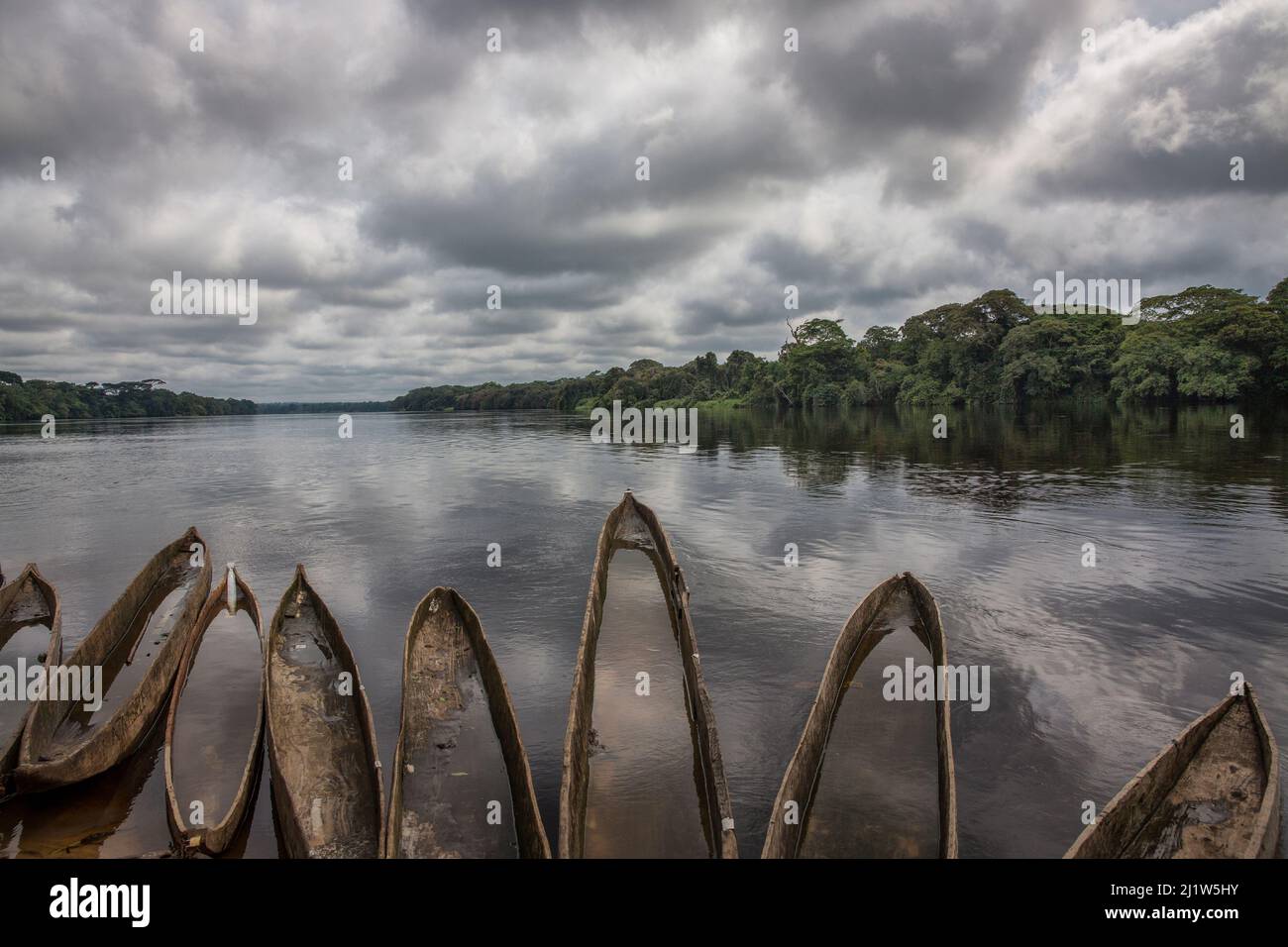 Traditional canoes, or pirogues, in the Lukenie River Democratic Republic of the Congo. Stock Photohttps://www.alamy.com/image-license-details/?v=1https://www.alamy.com/traditional-canoes-or-pirogues-in-the-lukenie-river-democratic-republic-of-the-congo-image465847815.html
Traditional canoes, or pirogues, in the Lukenie River Democratic Republic of the Congo. Stock Photohttps://www.alamy.com/image-license-details/?v=1https://www.alamy.com/traditional-canoes-or-pirogues-in-the-lukenie-river-democratic-republic-of-the-congo-image465847815.htmlRM2J1W5HY–Traditional canoes, or pirogues, in the Lukenie River Democratic Republic of the Congo.
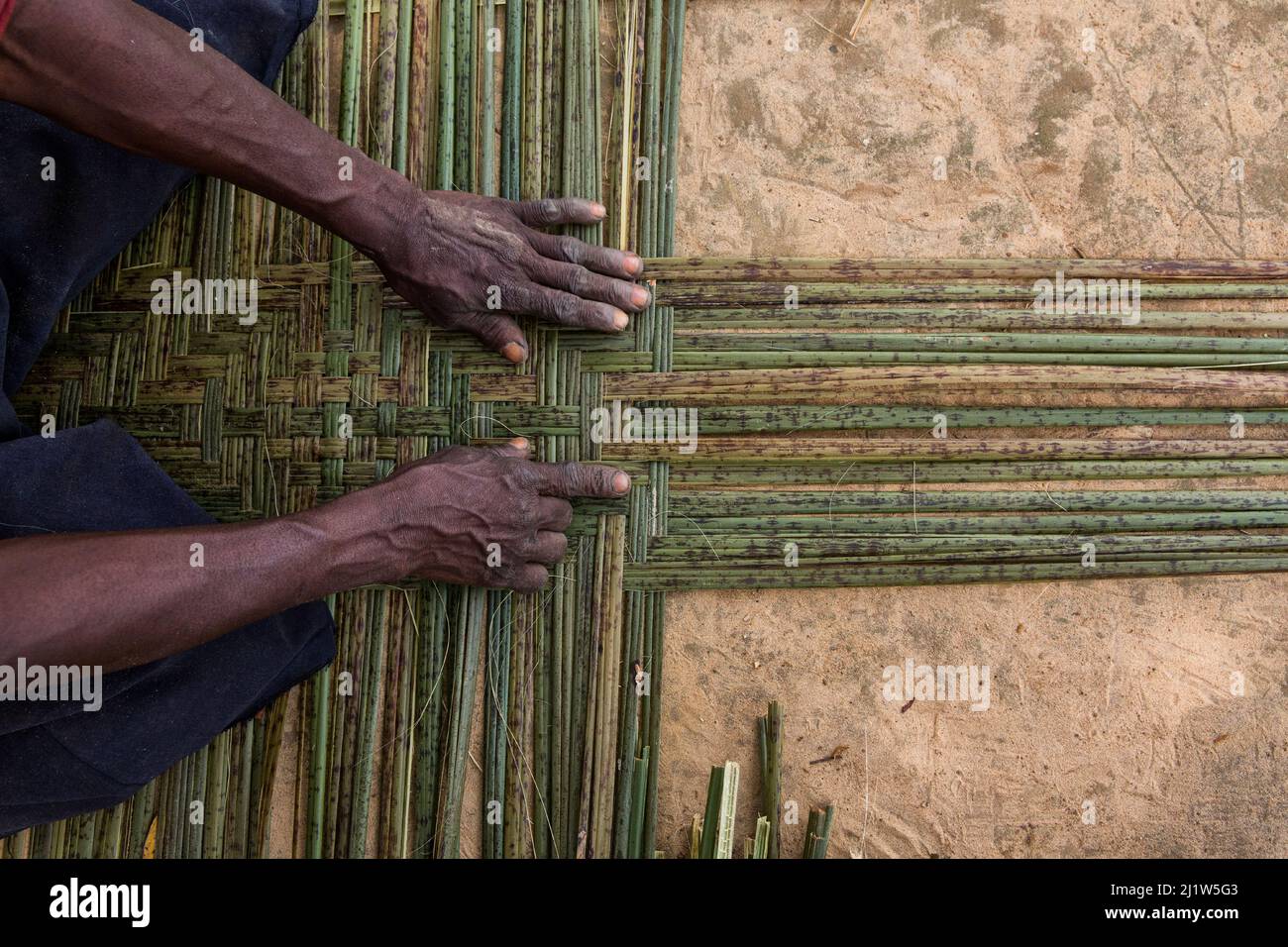 Local women weaving plants nto mats to later use or sell at markets. Democratic Republic of the Congo. Stock Photohttps://www.alamy.com/image-license-details/?v=1https://www.alamy.com/local-women-weaving-plants-nto-mats-to-later-use-or-sell-at-markets-democratic-republic-of-the-congo-image465847763.html
Local women weaving plants nto mats to later use or sell at markets. Democratic Republic of the Congo. Stock Photohttps://www.alamy.com/image-license-details/?v=1https://www.alamy.com/local-women-weaving-plants-nto-mats-to-later-use-or-sell-at-markets-democratic-republic-of-the-congo-image465847763.htmlRM2J1W5G3–Local women weaving plants nto mats to later use or sell at markets. Democratic Republic of the Congo.
 Wild sage / Buttonsage (Lantana involucrata) on black background, a favourite food of the Kirtland's Warbler food. Kirtland's Warbler (Setophaga kirtlandii) Cat Island, Bahamas. Stock Photohttps://www.alamy.com/image-license-details/?v=1https://www.alamy.com/wild-sage-buttonsage-lantana-involucrata-on-black-background-a-favourite-food-of-the-kirtland39s-warbler-food-kirtland39s-warbler-setophaga-kirtlandii-cat-island-bahamas-image612157502.html
Wild sage / Buttonsage (Lantana involucrata) on black background, a favourite food of the Kirtland's Warbler food. Kirtland's Warbler (Setophaga kirtlandii) Cat Island, Bahamas. Stock Photohttps://www.alamy.com/image-license-details/?v=1https://www.alamy.com/wild-sage-buttonsage-lantana-involucrata-on-black-background-a-favourite-food-of-the-kirtland39s-warbler-food-kirtland39s-warbler-setophaga-kirtlandii-cat-island-bahamas-image612157502.htmlRM2XFX53X–Wild sage / Buttonsage (Lantana involucrata) on black background, a favourite food of the Kirtland's Warbler food. Kirtland's Warbler (Setophaga kirtlandii) Cat Island, Bahamas.
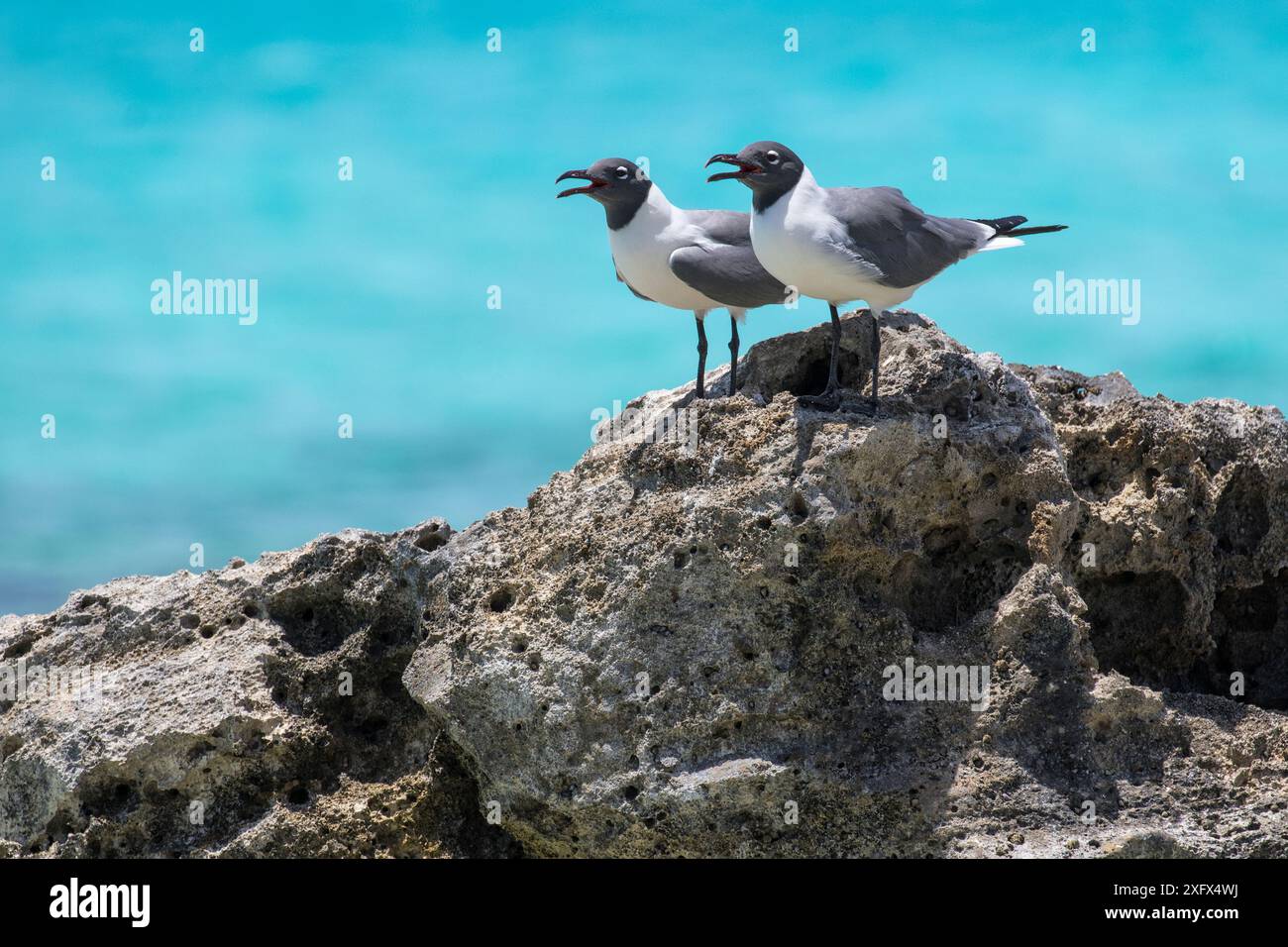 Laughing gulls (Leucophaeus atricilla) on the coast, Cat Island, Bahamas. Stock Photohttps://www.alamy.com/image-license-details/?v=1https://www.alamy.com/laughing-gulls-leucophaeus-atricilla-on-the-coast-cat-island-bahamas-image612157326.html
Laughing gulls (Leucophaeus atricilla) on the coast, Cat Island, Bahamas. Stock Photohttps://www.alamy.com/image-license-details/?v=1https://www.alamy.com/laughing-gulls-leucophaeus-atricilla-on-the-coast-cat-island-bahamas-image612157326.htmlRM2XFX4WJ–Laughing gulls (Leucophaeus atricilla) on the coast, Cat Island, Bahamas.
 Kirtland's warblers (Setophaga kirtlandii) fecal sample blots. Cat Island, Bahamas. April 2017. Stock Photohttps://www.alamy.com/image-license-details/?v=1https://www.alamy.com/kirtland39s-warblers-setophaga-kirtlandii-fecal-sample-blots-cat-island-bahamas-april-2017-image612157487.html
Kirtland's warblers (Setophaga kirtlandii) fecal sample blots. Cat Island, Bahamas. April 2017. Stock Photohttps://www.alamy.com/image-license-details/?v=1https://www.alamy.com/kirtland39s-warblers-setophaga-kirtlandii-fecal-sample-blots-cat-island-bahamas-april-2017-image612157487.htmlRM2XFX53B–Kirtland's warblers (Setophaga kirtlandii) fecal sample blots. Cat Island, Bahamas. April 2017.
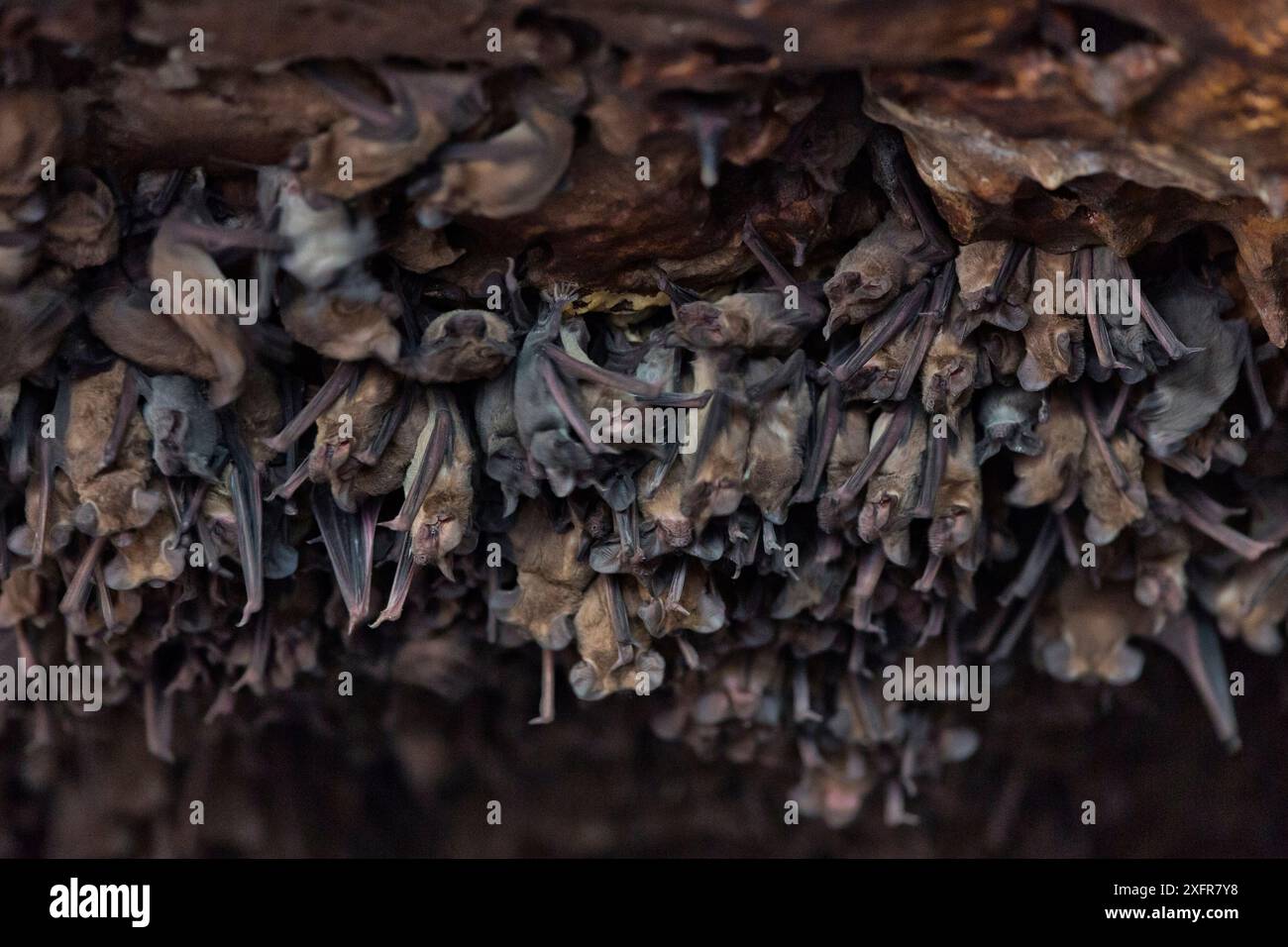 Mexican free-tailed bat (Tadarida brasiliensis) babies hanging on the wall at the entrance to Bracken Cave. Babies are born in early summer, and the mothers consume one-half to three-fourths their body weight in insects per night to feed them. Bracken Cave, San Antonio, Texas, USA, July. Stock Photohttps://www.alamy.com/image-license-details/?v=1https://www.alamy.com/mexican-free-tailed-bat-tadarida-brasiliensis-babies-hanging-on-the-wall-at-the-entrance-to-bracken-cave-babies-are-born-in-early-summer-and-the-mothers-consume-one-half-to-three-fourths-their-body-weight-in-insects-per-night-to-feed-them-bracken-cave-san-antonio-texas-usa-july-image612093868.html
Mexican free-tailed bat (Tadarida brasiliensis) babies hanging on the wall at the entrance to Bracken Cave. Babies are born in early summer, and the mothers consume one-half to three-fourths their body weight in insects per night to feed them. Bracken Cave, San Antonio, Texas, USA, July. Stock Photohttps://www.alamy.com/image-license-details/?v=1https://www.alamy.com/mexican-free-tailed-bat-tadarida-brasiliensis-babies-hanging-on-the-wall-at-the-entrance-to-bracken-cave-babies-are-born-in-early-summer-and-the-mothers-consume-one-half-to-three-fourths-their-body-weight-in-insects-per-night-to-feed-them-bracken-cave-san-antonio-texas-usa-july-image612093868.htmlRM2XFR7Y8–Mexican free-tailed bat (Tadarida brasiliensis) babies hanging on the wall at the entrance to Bracken Cave. Babies are born in early summer, and the mothers consume one-half to three-fourths their body weight in insects per night to feed them. Bracken Cave, San Antonio, Texas, USA, July.
 Mexican free-tailed bats (Tadarida brasiliensis) leaving maternity colony at night to feed, with red lighting at entrance to cave. Bracken Cave, San Antonio, Texas, USA, July. Bracken Cave is the world's largest bat maternity colony. Stock Photohttps://www.alamy.com/image-license-details/?v=1https://www.alamy.com/mexican-free-tailed-bats-tadarida-brasiliensis-leaving-maternity-colony-at-night-to-feed-with-red-lighting-at-entrance-to-cave-bracken-cave-san-antonio-texas-usa-july-bracken-cave-is-the-worlds-largest-bat-maternity-colony-image612093922.html
Mexican free-tailed bats (Tadarida brasiliensis) leaving maternity colony at night to feed, with red lighting at entrance to cave. Bracken Cave, San Antonio, Texas, USA, July. Bracken Cave is the world's largest bat maternity colony. Stock Photohttps://www.alamy.com/image-license-details/?v=1https://www.alamy.com/mexican-free-tailed-bats-tadarida-brasiliensis-leaving-maternity-colony-at-night-to-feed-with-red-lighting-at-entrance-to-cave-bracken-cave-san-antonio-texas-usa-july-bracken-cave-is-the-worlds-largest-bat-maternity-colony-image612093922.htmlRM2XFR816–Mexican free-tailed bats (Tadarida brasiliensis) leaving maternity colony at night to feed, with red lighting at entrance to cave. Bracken Cave, San Antonio, Texas, USA, July. Bracken Cave is the world's largest bat maternity colony.
 Mexican Free-Tailed Bat (Tadarida brasiliensis) in flight on black background in field studio, Texas, USA, July. Stock Photohttps://www.alamy.com/image-license-details/?v=1https://www.alamy.com/mexican-free-tailed-bat-tadarida-brasiliensis-in-flight-on-black-background-in-field-studio-texas-usa-july-image612093883.html
Mexican Free-Tailed Bat (Tadarida brasiliensis) in flight on black background in field studio, Texas, USA, July. Stock Photohttps://www.alamy.com/image-license-details/?v=1https://www.alamy.com/mexican-free-tailed-bat-tadarida-brasiliensis-in-flight-on-black-background-in-field-studio-texas-usa-july-image612093883.htmlRM2XFR7YR–Mexican Free-Tailed Bat (Tadarida brasiliensis) in flight on black background in field studio, Texas, USA, July.
 Mexican Free-Tailed Bat (Tadarida brasiliensis) in flight on black background in field studio, Texas, USA, July. Stock Photohttps://www.alamy.com/image-license-details/?v=1https://www.alamy.com/mexican-free-tailed-bat-tadarida-brasiliensis-in-flight-on-black-background-in-field-studio-texas-usa-july-image612093877.html
Mexican Free-Tailed Bat (Tadarida brasiliensis) in flight on black background in field studio, Texas, USA, July. Stock Photohttps://www.alamy.com/image-license-details/?v=1https://www.alamy.com/mexican-free-tailed-bat-tadarida-brasiliensis-in-flight-on-black-background-in-field-studio-texas-usa-july-image612093877.htmlRM2XFR7YH–Mexican Free-Tailed Bat (Tadarida brasiliensis) in flight on black background in field studio, Texas, USA, July.
 Tabby cat playing with fish toy at Kawaramati Cat Cafe Kyoto, Japan. Stock Photohttps://www.alamy.com/image-license-details/?v=1https://www.alamy.com/tabby-cat-playing-with-fish-toy-at-kawaramati-cat-cafe-kyoto-japan-image342310056.html
Tabby cat playing with fish toy at Kawaramati Cat Cafe Kyoto, Japan. Stock Photohttps://www.alamy.com/image-license-details/?v=1https://www.alamy.com/tabby-cat-playing-with-fish-toy-at-kawaramati-cat-cafe-kyoto-japan-image342310056.htmlRM2ATWFY4–Tabby cat playing with fish toy at Kawaramati Cat Cafe Kyoto, Japan.
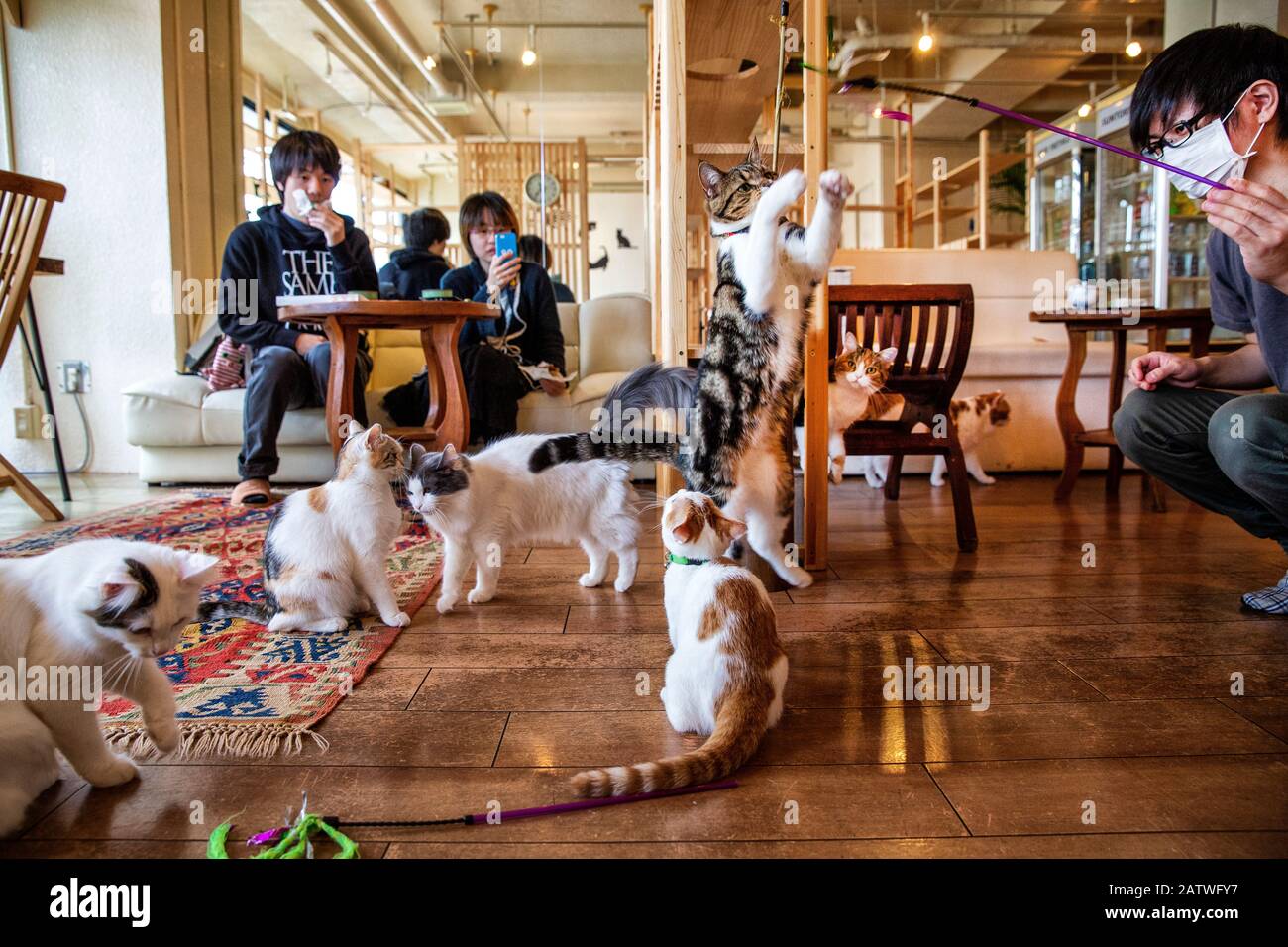 Japanese man playing with cats at the Kawaramati Cat Cafe Kyoto, Japan. Stock Photohttps://www.alamy.com/image-license-details/?v=1https://www.alamy.com/japanese-man-playing-with-cats-at-the-kawaramati-cat-cafe-kyoto-japan-image342310059.html
Japanese man playing with cats at the Kawaramati Cat Cafe Kyoto, Japan. Stock Photohttps://www.alamy.com/image-license-details/?v=1https://www.alamy.com/japanese-man-playing-with-cats-at-the-kawaramati-cat-cafe-kyoto-japan-image342310059.htmlRM2ATWFY7–Japanese man playing with cats at the Kawaramati Cat Cafe Kyoto, Japan.
 African wild dog (Lycaon Pictus) pups wait for the rest of the pack to lead the way. Mana Pools, Zimbabwe. Stock Photohttps://www.alamy.com/image-license-details/?v=1https://www.alamy.com/african-wild-dog-lycaon-pictus-pups-wait-for-the-rest-of-the-pack-to-lead-the-way-mana-pools-zimbabwe-image612157309.html
African wild dog (Lycaon Pictus) pups wait for the rest of the pack to lead the way. Mana Pools, Zimbabwe. Stock Photohttps://www.alamy.com/image-license-details/?v=1https://www.alamy.com/african-wild-dog-lycaon-pictus-pups-wait-for-the-rest-of-the-pack-to-lead-the-way-mana-pools-zimbabwe-image612157309.htmlRM2XFX4W1–African wild dog (Lycaon Pictus) pups wait for the rest of the pack to lead the way. Mana Pools, Zimbabwe.
 African wild dog (Lycaon Pictus) pups at dusk and looking around for the adults. Mana Pools, Zimbabwe. Stock Photohttps://www.alamy.com/image-license-details/?v=1https://www.alamy.com/african-wild-dog-lycaon-pictus-pups-at-dusk-and-looking-around-for-the-adults-mana-pools-zimbabwe-image612157230.html
African wild dog (Lycaon Pictus) pups at dusk and looking around for the adults. Mana Pools, Zimbabwe. Stock Photohttps://www.alamy.com/image-license-details/?v=1https://www.alamy.com/african-wild-dog-lycaon-pictus-pups-at-dusk-and-looking-around-for-the-adults-mana-pools-zimbabwe-image612157230.htmlRM2XFX4P6–African wild dog (Lycaon Pictus) pups at dusk and looking around for the adults. Mana Pools, Zimbabwe.
 African wild dog (Lycaon pictus) pups playing and greeting each other during social time after a hunt. Zimbabwe. Stock Photohttps://www.alamy.com/image-license-details/?v=1https://www.alamy.com/african-wild-dog-lycaon-pictus-pups-playing-and-greeting-each-other-during-social-time-after-a-hunt-zimbabwe-image612157232.html
African wild dog (Lycaon pictus) pups playing and greeting each other during social time after a hunt. Zimbabwe. Stock Photohttps://www.alamy.com/image-license-details/?v=1https://www.alamy.com/african-wild-dog-lycaon-pictus-pups-playing-and-greeting-each-other-during-social-time-after-a-hunt-zimbabwe-image612157232.htmlRM2XFX4P8–African wild dog (Lycaon pictus) pups playing and greeting each other during social time after a hunt. Zimbabwe.
 African wild dog (lycaon pictus) pups playing Malilangwe Wildlife Reserve, Zimbabwe. Stock Photohttps://www.alamy.com/image-license-details/?v=1https://www.alamy.com/african-wild-dog-lycaon-pictus-pups-playing-malilangwe-wildlife-reserve-zimbabwe-image612157317.html
African wild dog (lycaon pictus) pups playing Malilangwe Wildlife Reserve, Zimbabwe. Stock Photohttps://www.alamy.com/image-license-details/?v=1https://www.alamy.com/african-wild-dog-lycaon-pictus-pups-playing-malilangwe-wildlife-reserve-zimbabwe-image612157317.htmlRM2XFX4W9–African wild dog (lycaon pictus) pups playing Malilangwe Wildlife Reserve, Zimbabwe.
 African wild dog (lycaon pictus) pups playing with a stick. Malilangwe Wildlife Reserve, Zimbabwe. Stock Photohttps://www.alamy.com/image-license-details/?v=1https://www.alamy.com/african-wild-dog-lycaon-pictus-pups-playing-with-a-stick-malilangwe-wildlife-reserve-zimbabwe-image612157320.html
African wild dog (lycaon pictus) pups playing with a stick. Malilangwe Wildlife Reserve, Zimbabwe. Stock Photohttps://www.alamy.com/image-license-details/?v=1https://www.alamy.com/african-wild-dog-lycaon-pictus-pups-playing-with-a-stick-malilangwe-wildlife-reserve-zimbabwe-image612157320.htmlRM2XFX4WC–African wild dog (lycaon pictus) pups playing with a stick. Malilangwe Wildlife Reserve, Zimbabwe.
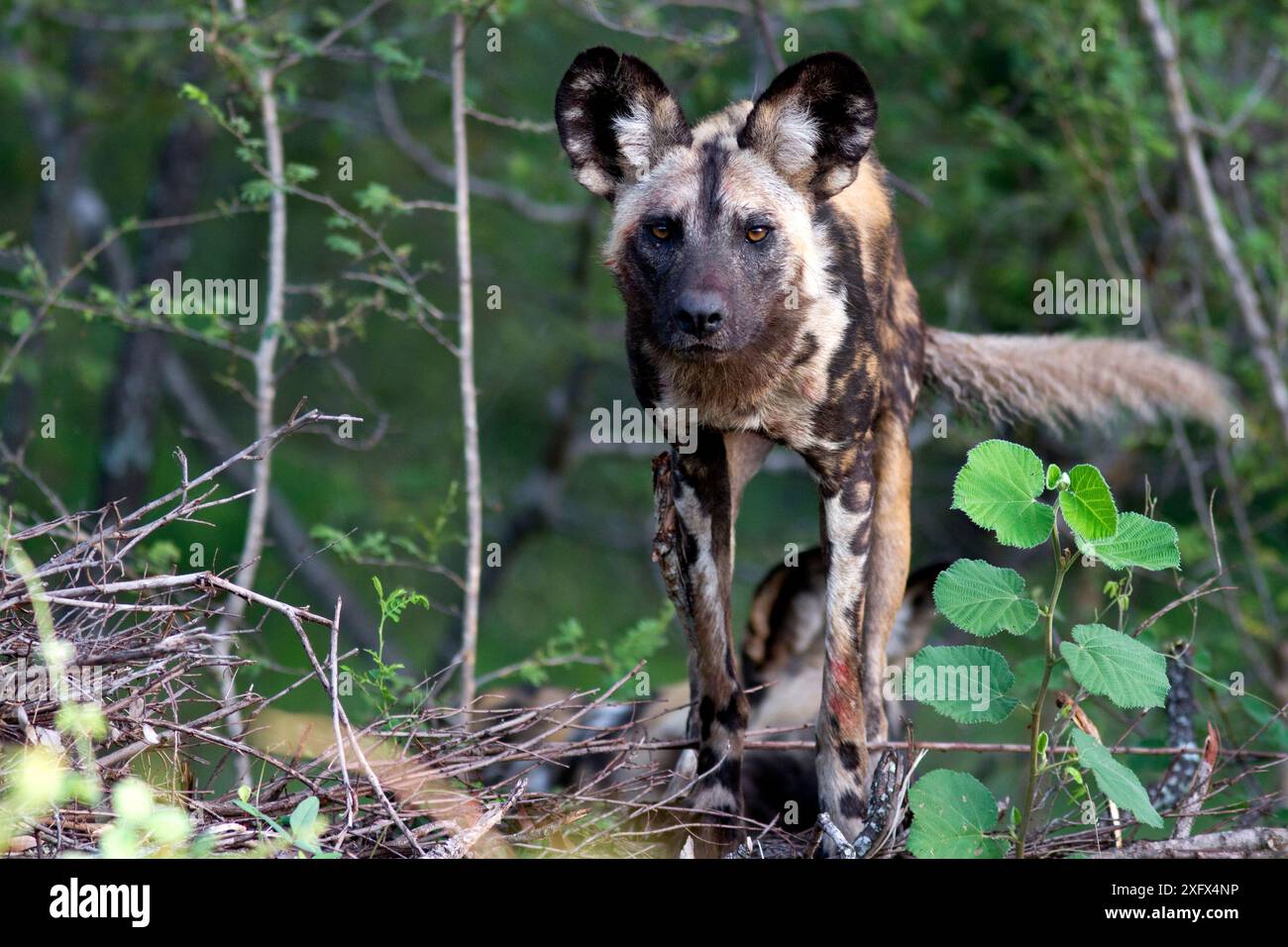 African wild dog (Lycaon pictus) staring intensely at the camera. Malilangwe Wildlife Reserve, Zimbabwe. Stock Photohttps://www.alamy.com/image-license-details/?v=1https://www.alamy.com/african-wild-dog-lycaon-pictus-staring-intensely-at-the-camera-malilangwe-wildlife-reserve-zimbabwe-image612157218.html
African wild dog (Lycaon pictus) staring intensely at the camera. Malilangwe Wildlife Reserve, Zimbabwe. Stock Photohttps://www.alamy.com/image-license-details/?v=1https://www.alamy.com/african-wild-dog-lycaon-pictus-staring-intensely-at-the-camera-malilangwe-wildlife-reserve-zimbabwe-image612157218.htmlRM2XFX4NP–African wild dog (Lycaon pictus) staring intensely at the camera. Malilangwe Wildlife Reserve, Zimbabwe.
 Volunteer, helping release a Hermit thrush (Catharus guttatus) from a mist net. The Thrush might be a possible cohort individual for a study on fat gain and antioxidants in diet before migration. Block island, Rhode Island, USA. Stock Photohttps://www.alamy.com/image-license-details/?v=1https://www.alamy.com/volunteer-helping-release-a-hermit-thrush-catharus-guttatus-from-a-mist-net-the-thrush-might-be-a-possible-cohort-individual-for-a-study-on-fat-gain-and-antioxidants-in-diet-before-migration-block-island-rhode-island-usa-image612157728.html
Volunteer, helping release a Hermit thrush (Catharus guttatus) from a mist net. The Thrush might be a possible cohort individual for a study on fat gain and antioxidants in diet before migration. Block island, Rhode Island, USA. Stock Photohttps://www.alamy.com/image-license-details/?v=1https://www.alamy.com/volunteer-helping-release-a-hermit-thrush-catharus-guttatus-from-a-mist-net-the-thrush-might-be-a-possible-cohort-individual-for-a-study-on-fat-gain-and-antioxidants-in-diet-before-migration-block-island-rhode-island-usa-image612157728.htmlRM2XFX5C0–Volunteer, helping release a Hermit thrush (Catharus guttatus) from a mist net. The Thrush might be a possible cohort individual for a study on fat gain and antioxidants in diet before migration. Block island, Rhode Island, USA.
 Biologist feeding Hermit thrush (Catharus guttatus) a mixture of elderberry powder. This powder is full of an antioxidant called anthocyanin. The anthocynanin is thought to help birds recover from and prepare for long migratory flights. Block island, Rhode Island, USA. Stock Photohttps://www.alamy.com/image-license-details/?v=1https://www.alamy.com/biologist-feeding-hermit-thrush-catharus-guttatus-a-mixture-of-elderberry-powder-this-powder-is-full-of-an-antioxidant-called-anthocyanin-the-anthocynanin-is-thought-to-help-birds-recover-from-and-prepare-for-long-migratory-flights-block-island-rhode-island-usa-image612157781.html
Biologist feeding Hermit thrush (Catharus guttatus) a mixture of elderberry powder. This powder is full of an antioxidant called anthocyanin. The anthocynanin is thought to help birds recover from and prepare for long migratory flights. Block island, Rhode Island, USA. Stock Photohttps://www.alamy.com/image-license-details/?v=1https://www.alamy.com/biologist-feeding-hermit-thrush-catharus-guttatus-a-mixture-of-elderberry-powder-this-powder-is-full-of-an-antioxidant-called-anthocyanin-the-anthocynanin-is-thought-to-help-birds-recover-from-and-prepare-for-long-migratory-flights-block-island-rhode-island-usa-image612157781.htmlRM2XFX5DW–Biologist feeding Hermit thrush (Catharus guttatus) a mixture of elderberry powder. This powder is full of an antioxidant called anthocyanin. The anthocynanin is thought to help birds recover from and prepare for long migratory flights. Block island, Rhode Island, USA.
 Portrait of a Winter wren (Troglodytes hiemalis) with white background, Block island, Rhode Island, USA. Bird caught during scientific research. Stock Photohttps://www.alamy.com/image-license-details/?v=1https://www.alamy.com/portrait-of-a-winter-wren-troglodytes-hiemalis-with-white-background-block-island-rhode-island-usa-bird-caught-during-scientific-research-image612157792.html
Portrait of a Winter wren (Troglodytes hiemalis) with white background, Block island, Rhode Island, USA. Bird caught during scientific research. Stock Photohttps://www.alamy.com/image-license-details/?v=1https://www.alamy.com/portrait-of-a-winter-wren-troglodytes-hiemalis-with-white-background-block-island-rhode-island-usa-bird-caught-during-scientific-research-image612157792.htmlRM2XFX5E8–Portrait of a Winter wren (Troglodytes hiemalis) with white background, Block island, Rhode Island, USA. Bird caught during scientific research.
 Portrait of a Hermit thrush(Catharus guttatus) with white background, Block island, Rhode Island, USA. Bird caught during scientific research. Stock Photohttps://www.alamy.com/image-license-details/?v=1https://www.alamy.com/portrait-of-a-hermit-thrushcatharus-guttatus-with-white-background-block-island-rhode-island-usa-bird-caught-during-scientific-research-image612157786.html
Portrait of a Hermit thrush(Catharus guttatus) with white background, Block island, Rhode Island, USA. Bird caught during scientific research. Stock Photohttps://www.alamy.com/image-license-details/?v=1https://www.alamy.com/portrait-of-a-hermit-thrushcatharus-guttatus-with-white-background-block-island-rhode-island-usa-bird-caught-during-scientific-research-image612157786.htmlRM2XFX5E2–Portrait of a Hermit thrush(Catharus guttatus) with white background, Block island, Rhode Island, USA. Bird caught during scientific research.
 Woman releasing a Hermit thrush (Catharus guttatus) from a mist net. Block island, Rhode Island, USA. Stock Photohttps://www.alamy.com/image-license-details/?v=1https://www.alamy.com/woman-releasing-a-hermit-thrush-catharus-guttatus-from-a-mist-net-block-island-rhode-island-usa-image612157730.html
Woman releasing a Hermit thrush (Catharus guttatus) from a mist net. Block island, Rhode Island, USA. Stock Photohttps://www.alamy.com/image-license-details/?v=1https://www.alamy.com/woman-releasing-a-hermit-thrush-catharus-guttatus-from-a-mist-net-block-island-rhode-island-usa-image612157730.htmlRM2XFX5C2–Woman releasing a Hermit thrush (Catharus guttatus) from a mist net. Block island, Rhode Island, USA.
 Hermit thrush (Catharus guttatus) captive during scientific study, with a wax worm. This bird is part of a study about weight gain, diet and condition prior to migration. Once the thrush has reached its proper weight it will be fitted with a nano transmitter and released. Block island, Rhode Island, USA. Stock Photohttps://www.alamy.com/image-license-details/?v=1https://www.alamy.com/hermit-thrush-catharus-guttatus-captive-during-scientific-study-with-a-wax-worm-this-bird-is-part-of-a-study-about-weight-gain-diet-and-condition-prior-to-migration-once-the-thrush-has-reached-its-proper-weight-it-will-be-fitted-with-a-nano-transmitter-and-released-block-island-rhode-island-usa-image612157720.html
Hermit thrush (Catharus guttatus) captive during scientific study, with a wax worm. This bird is part of a study about weight gain, diet and condition prior to migration. Once the thrush has reached its proper weight it will be fitted with a nano transmitter and released. Block island, Rhode Island, USA. Stock Photohttps://www.alamy.com/image-license-details/?v=1https://www.alamy.com/hermit-thrush-catharus-guttatus-captive-during-scientific-study-with-a-wax-worm-this-bird-is-part-of-a-study-about-weight-gain-diet-and-condition-prior-to-migration-once-the-thrush-has-reached-its-proper-weight-it-will-be-fitted-with-a-nano-transmitter-and-released-block-island-rhode-island-usa-image612157720.htmlRM2XFX5BM–Hermit thrush (Catharus guttatus) captive during scientific study, with a wax worm. This bird is part of a study about weight gain, diet and condition prior to migration. Once the thrush has reached its proper weight it will be fitted with a nano transmitter and released. Block island, Rhode Island, USA.
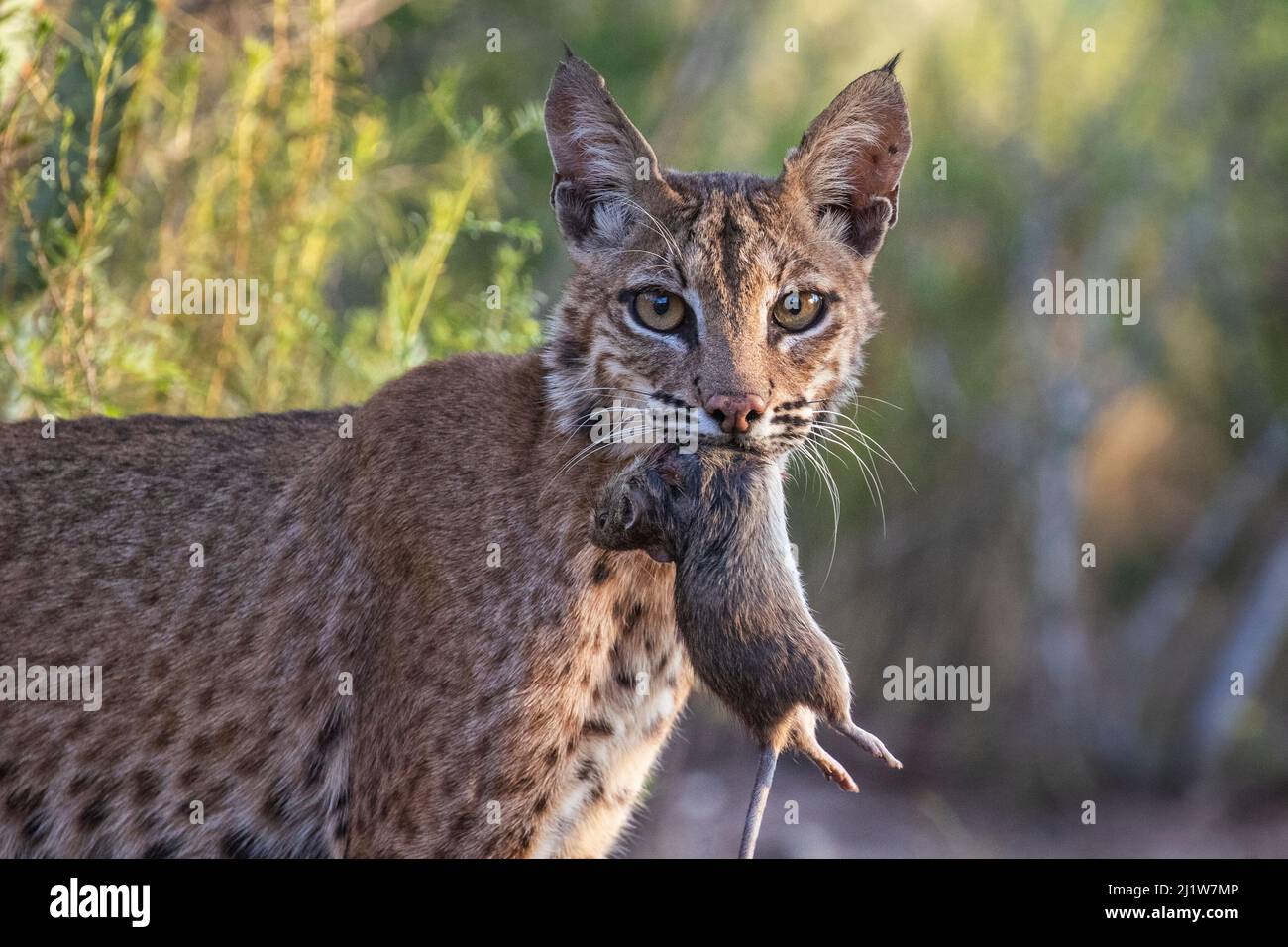 Portrait of a wild adult female Bobcat (Lynx rufus) with Hispid cotton rat (Sigmodon hispidus) prey, Texas, USA. September. Stock Photohttps://www.alamy.com/image-license-details/?v=1https://www.alamy.com/portrait-of-a-wild-adult-female-bobcat-lynx-rufus-with-hispid-cotton-rat-sigmodon-hispidus-prey-texas-usa-september-image465849462.html
Portrait of a wild adult female Bobcat (Lynx rufus) with Hispid cotton rat (Sigmodon hispidus) prey, Texas, USA. September. Stock Photohttps://www.alamy.com/image-license-details/?v=1https://www.alamy.com/portrait-of-a-wild-adult-female-bobcat-lynx-rufus-with-hispid-cotton-rat-sigmodon-hispidus-prey-texas-usa-september-image465849462.htmlRM2J1W7MP–Portrait of a wild adult female Bobcat (Lynx rufus) with Hispid cotton rat (Sigmodon hispidus) prey, Texas, USA. September.
 Cuban parakeet (Psittacara euops) preening, Bermejas, Cuba. Endemic. Stock Photohttps://www.alamy.com/image-license-details/?v=1https://www.alamy.com/cuban-parakeet-psittacara-euops-preening-bermejas-cuba-endemic-image342309931.html
Cuban parakeet (Psittacara euops) preening, Bermejas, Cuba. Endemic. Stock Photohttps://www.alamy.com/image-license-details/?v=1https://www.alamy.com/cuban-parakeet-psittacara-euops-preening-bermejas-cuba-endemic-image342309931.htmlRM2ATWFPK–Cuban parakeet (Psittacara euops) preening, Bermejas, Cuba. Endemic.
 Kirtland's warbler (Setophaga kirtlandii) female in jack pine carrying food for young. Michigan, USA, July. Stock Photohttps://www.alamy.com/image-license-details/?v=1https://www.alamy.com/kirtland39s-warbler-setophaga-kirtlandii-female-in-jack-pine-carrying-food-for-young-michigan-usa-july-image612157569.html
Kirtland's warbler (Setophaga kirtlandii) female in jack pine carrying food for young. Michigan, USA, July. Stock Photohttps://www.alamy.com/image-license-details/?v=1https://www.alamy.com/kirtland39s-warbler-setophaga-kirtlandii-female-in-jack-pine-carrying-food-for-young-michigan-usa-july-image612157569.htmlRM2XFX569–Kirtland's warbler (Setophaga kirtlandii) female in jack pine carrying food for young. Michigan, USA, July.
 Aerial view of tropical rainforest and meandering river, Salonga National Park, Democratic Republic of Congo May 2017. Stock Photohttps://www.alamy.com/image-license-details/?v=1https://www.alamy.com/aerial-view-of-tropical-rainforest-and-meandering-river-salonga-national-park-democratic-republic-of-congo-may-2017-image465847819.html
Aerial view of tropical rainforest and meandering river, Salonga National Park, Democratic Republic of Congo May 2017. Stock Photohttps://www.alamy.com/image-license-details/?v=1https://www.alamy.com/aerial-view-of-tropical-rainforest-and-meandering-river-salonga-national-park-democratic-republic-of-congo-may-2017-image465847819.htmlRM2J1W5J3–Aerial view of tropical rainforest and meandering river, Salonga National Park, Democratic Republic of Congo May 2017.
 Bonobo (Pan paniscus) in tree, Mpelu group, Malebo, Democratic Republic of Congo Stock Photohttps://www.alamy.com/image-license-details/?v=1https://www.alamy.com/bonobo-pan-paniscus-in-tree-mpelu-group-malebo-democratic-republic-of-congo-image465847945.html
Bonobo (Pan paniscus) in tree, Mpelu group, Malebo, Democratic Republic of Congo Stock Photohttps://www.alamy.com/image-license-details/?v=1https://www.alamy.com/bonobo-pan-paniscus-in-tree-mpelu-group-malebo-democratic-republic-of-congo-image465847945.htmlRM2J1W5PH–Bonobo (Pan paniscus) in tree, Mpelu group, Malebo, Democratic Republic of Congo
 Black-necked stilt (Himantopus mexicanus) Cat Island, Bahamas. Stock Photohttps://www.alamy.com/image-license-details/?v=1https://www.alamy.com/black-necked-stilt-himantopus-mexicanus-cat-island-bahamas-image612157331.html
Black-necked stilt (Himantopus mexicanus) Cat Island, Bahamas. Stock Photohttps://www.alamy.com/image-license-details/?v=1https://www.alamy.com/black-necked-stilt-himantopus-mexicanus-cat-island-bahamas-image612157331.htmlRM2XFX4WR–Black-necked stilt (Himantopus mexicanus) Cat Island, Bahamas.
 Scientist Nathan Cooper adjusting nano-tag put on a Kirtland's warbler (Setophaga kirtlandii) Cat Island, Bahamas, April 2017. Stock Photohttps://www.alamy.com/image-license-details/?v=1https://www.alamy.com/scientist-nathan-cooper-adjusting-nano-tag-put-on-a-kirtland39s-warbler-setophaga-kirtlandii-cat-island-bahamas-april-2017-image612157515.html
Scientist Nathan Cooper adjusting nano-tag put on a Kirtland's warbler (Setophaga kirtlandii) Cat Island, Bahamas, April 2017. Stock Photohttps://www.alamy.com/image-license-details/?v=1https://www.alamy.com/scientist-nathan-cooper-adjusting-nano-tag-put-on-a-kirtland39s-warbler-setophaga-kirtlandii-cat-island-bahamas-april-2017-image612157515.htmlRM2XFX54B–Scientist Nathan Cooper adjusting nano-tag put on a Kirtland's warbler (Setophaga kirtlandii) Cat Island, Bahamas, April 2017.
 Scientists Nathan Cooper and Stephen Caird play the call of a Kirtland's Warbler (Setophaga kirtlandii) to elicit a response from wild warblers. This is so they know where to set up a mist net to capture the birds and deploy nano-tags. Cat Island, Bahamas. April 2017. Stock Photohttps://www.alamy.com/image-license-details/?v=1https://www.alamy.com/scientists-nathan-cooper-and-stephen-caird-play-the-call-of-a-kirtland39s-warbler-setophaga-kirtlandii-to-elicit-a-response-from-wild-warblers-this-is-so-they-know-where-to-set-up-a-mist-net-to-capture-the-birds-and-deploy-nano-tags-cat-island-bahamas-april-2017-image612157493.html
Scientists Nathan Cooper and Stephen Caird play the call of a Kirtland's Warbler (Setophaga kirtlandii) to elicit a response from wild warblers. This is so they know where to set up a mist net to capture the birds and deploy nano-tags. Cat Island, Bahamas. April 2017. Stock Photohttps://www.alamy.com/image-license-details/?v=1https://www.alamy.com/scientists-nathan-cooper-and-stephen-caird-play-the-call-of-a-kirtland39s-warbler-setophaga-kirtlandii-to-elicit-a-response-from-wild-warblers-this-is-so-they-know-where-to-set-up-a-mist-net-to-capture-the-birds-and-deploy-nano-tags-cat-island-bahamas-april-2017-image612157493.htmlRM2XFX53H–Scientists Nathan Cooper and Stephen Caird play the call of a Kirtland's Warbler (Setophaga kirtlandii) to elicit a response from wild warblers. This is so they know where to set up a mist net to capture the birds and deploy nano-tags. Cat Island, Bahamas. April 2017.
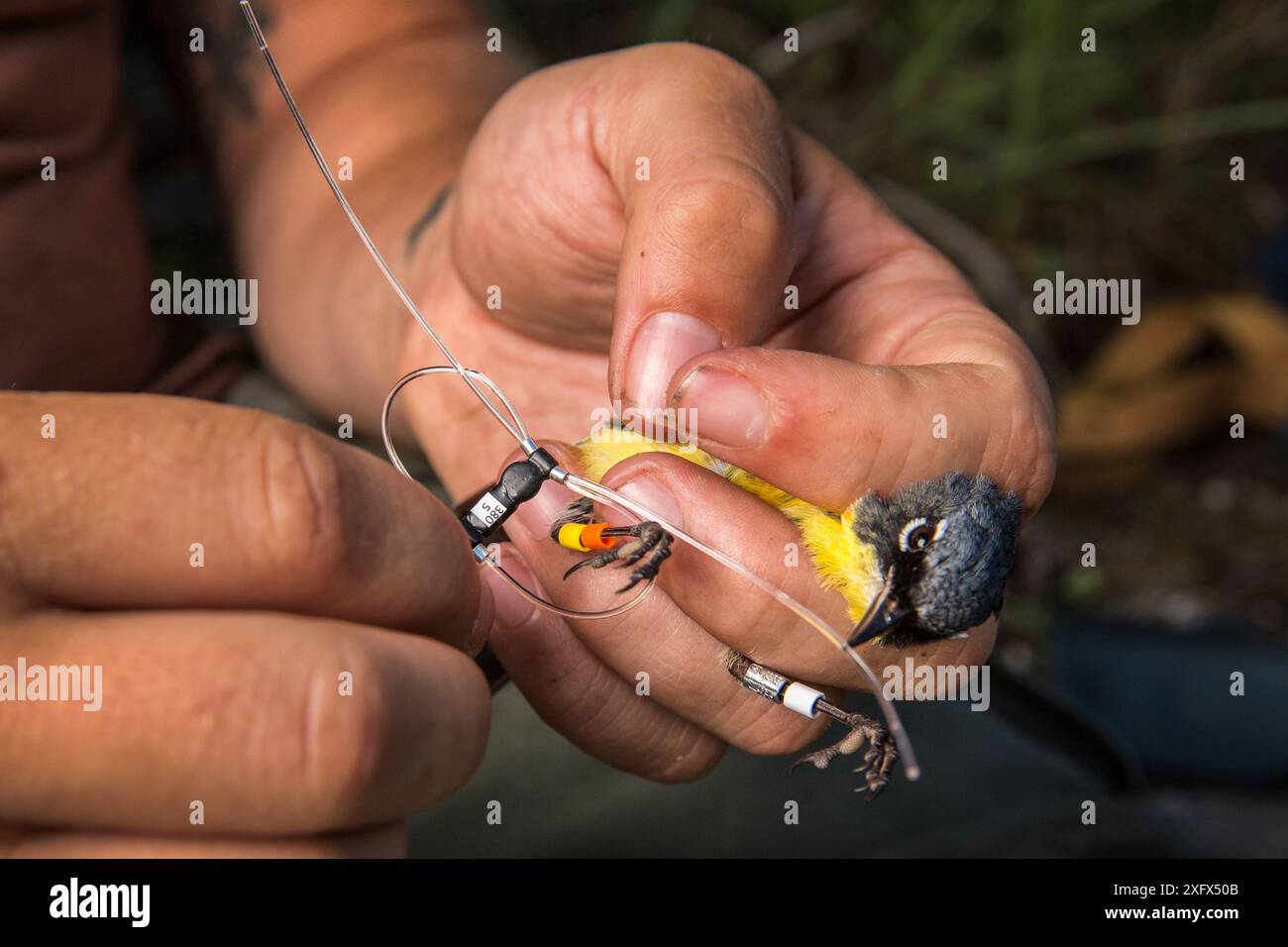 Scientist Nathan Cooper puts a nano-tag on a Kirtland's warbler (Setophaga kirtlandii) Cat Island, Bahamas. April 2017. Stock Photohttps://www.alamy.com/image-license-details/?v=1https://www.alamy.com/scientist-nathan-cooper-puts-a-nano-tag-on-a-kirtland39s-warbler-setophaga-kirtlandii-cat-island-bahamas-april-2017-image612157403.html
Scientist Nathan Cooper puts a nano-tag on a Kirtland's warbler (Setophaga kirtlandii) Cat Island, Bahamas. April 2017. Stock Photohttps://www.alamy.com/image-license-details/?v=1https://www.alamy.com/scientist-nathan-cooper-puts-a-nano-tag-on-a-kirtland39s-warbler-setophaga-kirtlandii-cat-island-bahamas-april-2017-image612157403.htmlRM2XFX50B–Scientist Nathan Cooper puts a nano-tag on a Kirtland's warbler (Setophaga kirtlandii) Cat Island, Bahamas. April 2017.
 Northern curly-tailed lizard (Leiocephalus carinatus) Cat Island, Bahamas Stock Photohttps://www.alamy.com/image-license-details/?v=1https://www.alamy.com/northern-curly-tailed-lizard-leiocephalus-carinatus-cat-island-bahamas-image612157583.html
Northern curly-tailed lizard (Leiocephalus carinatus) Cat Island, Bahamas Stock Photohttps://www.alamy.com/image-license-details/?v=1https://www.alamy.com/northern-curly-tailed-lizard-leiocephalus-carinatus-cat-island-bahamas-image612157583.htmlRM2XFX56R–Northern curly-tailed lizard (Leiocephalus carinatus) Cat Island, Bahamas
 Landscape of beach on Cat Island. Bahamas. April 2017. Stock Photohttps://www.alamy.com/image-license-details/?v=1https://www.alamy.com/landscape-of-beach-on-cat-island-bahamas-april-2017-image612157418.html
Landscape of beach on Cat Island. Bahamas. April 2017. Stock Photohttps://www.alamy.com/image-license-details/?v=1https://www.alamy.com/landscape-of-beach-on-cat-island-bahamas-april-2017-image612157418.htmlRM2XFX50X–Landscape of beach on Cat Island. Bahamas. April 2017.
 Director of Bat Conservation International's Bracken Cave Preserve standing at the mouth of Bracken Cave, holding one of his teaching placards, Bracken Cave, San Antonio, Texas, USA, July 2015. Stock Photohttps://www.alamy.com/image-license-details/?v=1https://www.alamy.com/director-of-bat-conservation-internationals-bracken-cave-preserve-standing-at-the-mouth-of-bracken-cave-holding-one-of-his-teaching-placards-bracken-cave-san-antonio-texas-usa-july-2015-image612093895.html
Director of Bat Conservation International's Bracken Cave Preserve standing at the mouth of Bracken Cave, holding one of his teaching placards, Bracken Cave, San Antonio, Texas, USA, July 2015. Stock Photohttps://www.alamy.com/image-license-details/?v=1https://www.alamy.com/director-of-bat-conservation-internationals-bracken-cave-preserve-standing-at-the-mouth-of-bracken-cave-holding-one-of-his-teaching-placards-bracken-cave-san-antonio-texas-usa-july-2015-image612093895.htmlRM2XFR807–Director of Bat Conservation International's Bracken Cave Preserve standing at the mouth of Bracken Cave, holding one of his teaching placards, Bracken Cave, San Antonio, Texas, USA, July 2015.
 Mexican free-tailed bat (Tadarida brasiliensis) babies hanging on the wall at the entrance to Bracken Cave. Babies are born in early summer, and the mothers consume one-half to three-fourths their body weight in insects per night to feed them. Bracken Cave, San Antonio, Texas, USA, July. Stock Photohttps://www.alamy.com/image-license-details/?v=1https://www.alamy.com/mexican-free-tailed-bat-tadarida-brasiliensis-babies-hanging-on-the-wall-at-the-entrance-to-bracken-cave-babies-are-born-in-early-summer-and-the-mothers-consume-one-half-to-three-fourths-their-body-weight-in-insects-per-night-to-feed-them-bracken-cave-san-antonio-texas-usa-july-image612093901.html
Mexican free-tailed bat (Tadarida brasiliensis) babies hanging on the wall at the entrance to Bracken Cave. Babies are born in early summer, and the mothers consume one-half to three-fourths their body weight in insects per night to feed them. Bracken Cave, San Antonio, Texas, USA, July. Stock Photohttps://www.alamy.com/image-license-details/?v=1https://www.alamy.com/mexican-free-tailed-bat-tadarida-brasiliensis-babies-hanging-on-the-wall-at-the-entrance-to-bracken-cave-babies-are-born-in-early-summer-and-the-mothers-consume-one-half-to-three-fourths-their-body-weight-in-insects-per-night-to-feed-them-bracken-cave-san-antonio-texas-usa-july-image612093901.htmlRM2XFR80D–Mexican free-tailed bat (Tadarida brasiliensis) babies hanging on the wall at the entrance to Bracken Cave. Babies are born in early summer, and the mothers consume one-half to three-fourths their body weight in insects per night to feed them. Bracken Cave, San Antonio, Texas, USA, July.
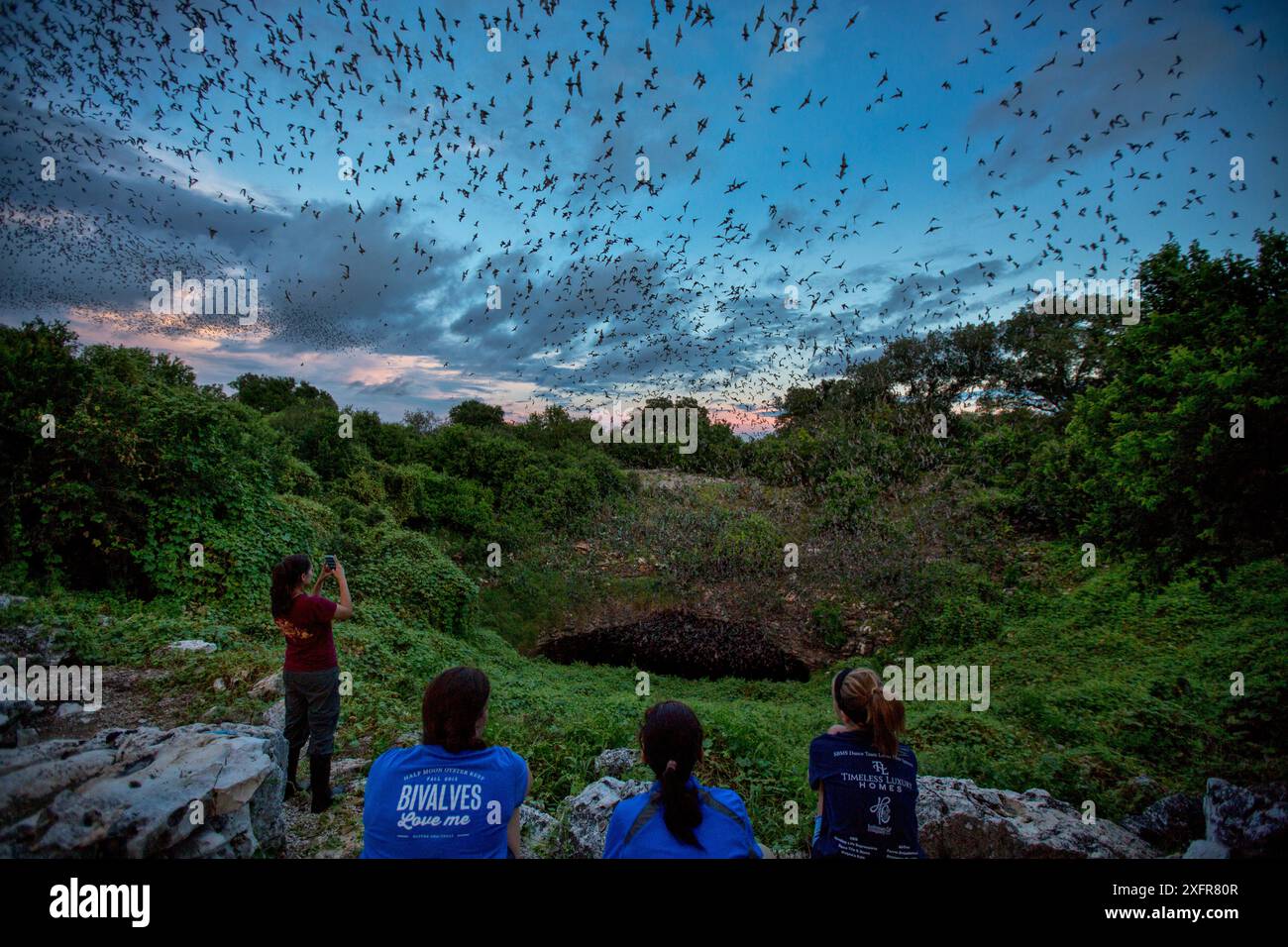 People watching masses of Mexican free-tailed bats (Tadarida brasiliensis) leaving maternity colony at night to feed, Bracken Cave, San Antonio, Texas, USA, June. Bracken Cave is the world's largest bat maternity colony. Stock Photohttps://www.alamy.com/image-license-details/?v=1https://www.alamy.com/people-watching-masses-of-mexican-free-tailed-bats-tadarida-brasiliensis-leaving-maternity-colony-at-night-to-feed-bracken-cave-san-antonio-texas-usa-june-bracken-cave-is-the-worlds-largest-bat-maternity-colony-image612093911.html
People watching masses of Mexican free-tailed bats (Tadarida brasiliensis) leaving maternity colony at night to feed, Bracken Cave, San Antonio, Texas, USA, June. Bracken Cave is the world's largest bat maternity colony. Stock Photohttps://www.alamy.com/image-license-details/?v=1https://www.alamy.com/people-watching-masses-of-mexican-free-tailed-bats-tadarida-brasiliensis-leaving-maternity-colony-at-night-to-feed-bracken-cave-san-antonio-texas-usa-june-bracken-cave-is-the-worlds-largest-bat-maternity-colony-image612093911.htmlRM2XFR80R–People watching masses of Mexican free-tailed bats (Tadarida brasiliensis) leaving maternity colony at night to feed, Bracken Cave, San Antonio, Texas, USA, June. Bracken Cave is the world's largest bat maternity colony.
 Cats sitting in window at Kawaramati Cat Cafe, Kyoto, Japan Stock Photohttps://www.alamy.com/image-license-details/?v=1https://www.alamy.com/cats-sitting-in-window-at-kawaramati-cat-cafe-kyoto-japan-image342310054.html
Cats sitting in window at Kawaramati Cat Cafe, Kyoto, Japan Stock Photohttps://www.alamy.com/image-license-details/?v=1https://www.alamy.com/cats-sitting-in-window-at-kawaramati-cat-cafe-kyoto-japan-image342310054.htmlRM2ATWFY2–Cats sitting in window at Kawaramati Cat Cafe, Kyoto, Japan
 Portrait of an African wild dog (Lycaon pictus) pup, looking at the camera. Mana Pools, Zimbabwe. Stock Photohttps://www.alamy.com/image-license-details/?v=1https://www.alamy.com/portrait-of-an-african-wild-dog-lycaon-pictus-pup-looking-at-the-camera-mana-pools-zimbabwe-image612157220.html
Portrait of an African wild dog (Lycaon pictus) pup, looking at the camera. Mana Pools, Zimbabwe. Stock Photohttps://www.alamy.com/image-license-details/?v=1https://www.alamy.com/portrait-of-an-african-wild-dog-lycaon-pictus-pup-looking-at-the-camera-mana-pools-zimbabwe-image612157220.htmlRM2XFX4NT–Portrait of an African wild dog (Lycaon pictus) pup, looking at the camera. Mana Pools, Zimbabwe.
 Blue wildebeest (Connochaetes taurinus) huddled together in a circle, protecting each other from a pack of four African wild dogs (Lycaon Pictus). Botswana. Stock Photohttps://www.alamy.com/image-license-details/?v=1https://www.alamy.com/blue-wildebeest-connochaetes-taurinus-huddled-together-in-a-circle-protecting-each-other-from-a-pack-of-four-african-wild-dogs-lycaon-pictus-botswana-image612157235.html
Blue wildebeest (Connochaetes taurinus) huddled together in a circle, protecting each other from a pack of four African wild dogs (Lycaon Pictus). Botswana. Stock Photohttps://www.alamy.com/image-license-details/?v=1https://www.alamy.com/blue-wildebeest-connochaetes-taurinus-huddled-together-in-a-circle-protecting-each-other-from-a-pack-of-four-african-wild-dogs-lycaon-pictus-botswana-image612157235.htmlRM2XFX4PB–Blue wildebeest (Connochaetes taurinus) huddled together in a circle, protecting each other from a pack of four African wild dogs (Lycaon Pictus). Botswana.
 African wild dog (Lycaon pictus) running in blurred motion while hunting at dusk. Linyanti Wildlife Reserve, Botswana. Stock Photohttps://www.alamy.com/image-license-details/?v=1https://www.alamy.com/african-wild-dog-lycaon-pictus-running-in-blurred-motion-while-hunting-at-dusk-linyanti-wildlife-reserve-botswana-image612157222.html
African wild dog (Lycaon pictus) running in blurred motion while hunting at dusk. Linyanti Wildlife Reserve, Botswana. Stock Photohttps://www.alamy.com/image-license-details/?v=1https://www.alamy.com/african-wild-dog-lycaon-pictus-running-in-blurred-motion-while-hunting-at-dusk-linyanti-wildlife-reserve-botswana-image612157222.htmlRM2XFX4NX–African wild dog (Lycaon pictus) running in blurred motion while hunting at dusk. Linyanti Wildlife Reserve, Botswana.
 Portrait of a American robin, (Turdus migratorius) male with white background, Block island, Rhode Island, USA. Bird caught during scientific research. Stock Photohttps://www.alamy.com/image-license-details/?v=1https://www.alamy.com/portrait-of-a-american-robin-turdus-migratorius-male-with-white-background-block-island-rhode-island-usa-bird-caught-during-scientific-research-image612157638.html
Portrait of a American robin, (Turdus migratorius) male with white background, Block island, Rhode Island, USA. Bird caught during scientific research. Stock Photohttps://www.alamy.com/image-license-details/?v=1https://www.alamy.com/portrait-of-a-american-robin-turdus-migratorius-male-with-white-background-block-island-rhode-island-usa-bird-caught-during-scientific-research-image612157638.htmlRM2XFX58P–Portrait of a American robin, (Turdus migratorius) male with white background, Block island, Rhode Island, USA. Bird caught during scientific research.
 Portrait of a Red-breasted nuthatch, (Sitta canadensis) with white background, Block island, Rhode Island, USA. Bird caught during scientific research. Stock Photohttps://www.alamy.com/image-license-details/?v=1https://www.alamy.com/portrait-of-a-red-breasted-nuthatch-sitta-canadensis-with-white-background-block-island-rhode-island-usa-bird-caught-during-scientific-research-image612157706.html
Portrait of a Red-breasted nuthatch, (Sitta canadensis) with white background, Block island, Rhode Island, USA. Bird caught during scientific research. Stock Photohttps://www.alamy.com/image-license-details/?v=1https://www.alamy.com/portrait-of-a-red-breasted-nuthatch-sitta-canadensis-with-white-background-block-island-rhode-island-usa-bird-caught-during-scientific-research-image612157706.htmlRM2XFX5B6–Portrait of a Red-breasted nuthatch, (Sitta canadensis) with white background, Block island, Rhode Island, USA. Bird caught during scientific research.
 Hermit thrush (Catharus guttatus) caught in a mist net. Block island, Rhode Island, USA. Stock Photohttps://www.alamy.com/image-license-details/?v=1https://www.alamy.com/hermit-thrush-catharus-guttatus-caught-in-a-mist-net-block-island-rhode-island-usa-image612157695.html
Hermit thrush (Catharus guttatus) caught in a mist net. Block island, Rhode Island, USA. Stock Photohttps://www.alamy.com/image-license-details/?v=1https://www.alamy.com/hermit-thrush-catharus-guttatus-caught-in-a-mist-net-block-island-rhode-island-usa-image612157695.htmlRM2XFX5AR–Hermit thrush (Catharus guttatus) caught in a mist net. Block island, Rhode Island, USA.
 Portrait of a White-throated sparrow, (Zonotrichia albicollis) with white background, Block island, Rhode Island, USA. Bird caught during scientific research. Stock Photohttps://www.alamy.com/image-license-details/?v=1https://www.alamy.com/portrait-of-a-white-throated-sparrow-zonotrichia-albicollis-with-white-background-block-island-rhode-island-usa-bird-caught-during-scientific-research-image612157721.html
Portrait of a White-throated sparrow, (Zonotrichia albicollis) with white background, Block island, Rhode Island, USA. Bird caught during scientific research. Stock Photohttps://www.alamy.com/image-license-details/?v=1https://www.alamy.com/portrait-of-a-white-throated-sparrow-zonotrichia-albicollis-with-white-background-block-island-rhode-island-usa-bird-caught-during-scientific-research-image612157721.htmlRM2XFX5BN–Portrait of a White-throated sparrow, (Zonotrichia albicollis) with white background, Block island, Rhode Island, USA. Bird caught during scientific research.
 Wax worms are portioned out by weight as biologist studying Hermit thrush (Catharus guttatus). The food is weighed out to test how much food it takes for the birds to fatten adequately before migration. Block island, Rhode Island, USA. Stock Photohttps://www.alamy.com/image-license-details/?v=1https://www.alamy.com/wax-worms-are-portioned-out-by-weight-as-biologist-studying-hermit-thrush-catharus-guttatus-the-food-is-weighed-out-to-test-how-much-food-it-takes-for-the-birds-to-fatten-adequately-before-migration-block-island-rhode-island-usa-image612157788.html
Wax worms are portioned out by weight as biologist studying Hermit thrush (Catharus guttatus). The food is weighed out to test how much food it takes for the birds to fatten adequately before migration. Block island, Rhode Island, USA. Stock Photohttps://www.alamy.com/image-license-details/?v=1https://www.alamy.com/wax-worms-are-portioned-out-by-weight-as-biologist-studying-hermit-thrush-catharus-guttatus-the-food-is-weighed-out-to-test-how-much-food-it-takes-for-the-birds-to-fatten-adequately-before-migration-block-island-rhode-island-usa-image612157788.htmlRM2XFX5E4–Wax worms are portioned out by weight as biologist studying Hermit thrush (Catharus guttatus). The food is weighed out to test how much food it takes for the birds to fatten adequately before migration. Block island, Rhode Island, USA.
 Bee hummingbird (Mellisuga helenae) male, the world's smallest bird, endemic to Cuba. Cienaga de Zapata National Park, Cuba Stock Photohttps://www.alamy.com/image-license-details/?v=1https://www.alamy.com/bee-hummingbird-mellisuga-helenae-male-the-worlds-smallest-bird-endemic-to-cuba-cienaga-de-zapata-national-park-cuba-image612135125.html
Bee hummingbird (Mellisuga helenae) male, the world's smallest bird, endemic to Cuba. Cienaga de Zapata National Park, Cuba Stock Photohttps://www.alamy.com/image-license-details/?v=1https://www.alamy.com/bee-hummingbird-mellisuga-helenae-male-the-worlds-smallest-bird-endemic-to-cuba-cienaga-de-zapata-national-park-cuba-image612135125.htmlRM2XFW4GN–Bee hummingbird (Mellisuga helenae) male, the world's smallest bird, endemic to Cuba. Cienaga de Zapata National Park, Cuba
 Biologist blowing on the breast of a Hermit thrush (Catharus guttatus) in order to separate feathers to see how much fat the bird has gained. Fat gain is important for migratory birds as they use a lot of energy during migration. Block island, Rhode Island, USA. Stock Photohttps://www.alamy.com/image-license-details/?v=1https://www.alamy.com/biologist-blowing-on-the-breast-of-a-hermit-thrush-catharus-guttatus-in-order-to-separate-feathers-to-see-how-much-fat-the-bird-has-gained-fat-gain-is-important-for-migratory-birds-as-they-use-a-lot-of-energy-during-migration-block-island-rhode-island-usa-image612157787.html
Biologist blowing on the breast of a Hermit thrush (Catharus guttatus) in order to separate feathers to see how much fat the bird has gained. Fat gain is important for migratory birds as they use a lot of energy during migration. Block island, Rhode Island, USA. Stock Photohttps://www.alamy.com/image-license-details/?v=1https://www.alamy.com/biologist-blowing-on-the-breast-of-a-hermit-thrush-catharus-guttatus-in-order-to-separate-feathers-to-see-how-much-fat-the-bird-has-gained-fat-gain-is-important-for-migratory-birds-as-they-use-a-lot-of-energy-during-migration-block-island-rhode-island-usa-image612157787.htmlRM2XFX5E3–Biologist blowing on the breast of a Hermit thrush (Catharus guttatus) in order to separate feathers to see how much fat the bird has gained. Fat gain is important for migratory birds as they use a lot of energy during migration. Block island, Rhode Island, USA.
 Upland sandpiper (Bartramia longicauda) Michigan, USA, July. Stock Photohttps://www.alamy.com/image-license-details/?v=1https://www.alamy.com/upland-sandpiper-bartramia-longicauda-michigan-usa-july-image612157579.html
Upland sandpiper (Bartramia longicauda) Michigan, USA, July. Stock Photohttps://www.alamy.com/image-license-details/?v=1https://www.alamy.com/upland-sandpiper-bartramia-longicauda-michigan-usa-july-image612157579.htmlRM2XFX56K–Upland sandpiper (Bartramia longicauda) Michigan, USA, July.
 Researcher pulls back the undergrowth to reveal the ground nest of a Kirtland's warbler (Setophaga kirtlandii) family, Michigan, USA, July 2017. Stock Photohttps://www.alamy.com/image-license-details/?v=1https://www.alamy.com/researcher-pulls-back-the-undergrowth-to-reveal-the-ground-nest-of-a-kirtland39s-warbler-setophaga-kirtlandii-family-michigan-usa-july-2017-image612157573.html
Researcher pulls back the undergrowth to reveal the ground nest of a Kirtland's warbler (Setophaga kirtlandii) family, Michigan, USA, July 2017. Stock Photohttps://www.alamy.com/image-license-details/?v=1https://www.alamy.com/researcher-pulls-back-the-undergrowth-to-reveal-the-ground-nest-of-a-kirtland39s-warbler-setophaga-kirtlandii-family-michigan-usa-july-2017-image612157573.htmlRM2XFX56D–Researcher pulls back the undergrowth to reveal the ground nest of a Kirtland's warbler (Setophaga kirtlandii) family, Michigan, USA, July 2017.
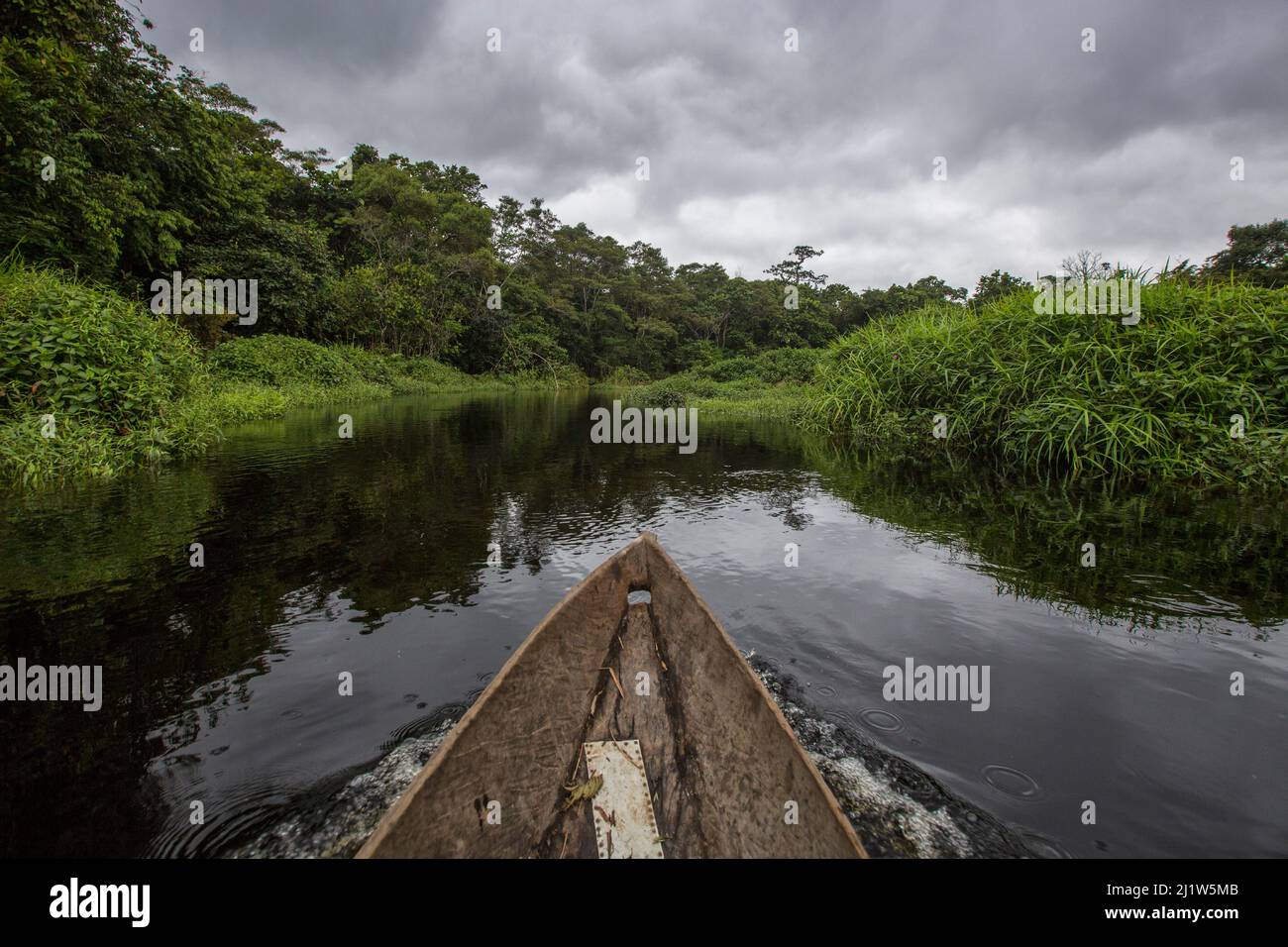 View from pirogue canoe, navigating the waterways of Bekalikali Bai, Salonga National Park Democratic Republic of Congo. May 2017. Stock Photohttps://www.alamy.com/image-license-details/?v=1https://www.alamy.com/view-from-pirogue-canoe-navigating-the-waterways-of-bekalikali-bai-salonga-national-park-democratic-republic-of-congo-may-2017-image465847883.html
View from pirogue canoe, navigating the waterways of Bekalikali Bai, Salonga National Park Democratic Republic of Congo. May 2017. Stock Photohttps://www.alamy.com/image-license-details/?v=1https://www.alamy.com/view-from-pirogue-canoe-navigating-the-waterways-of-bekalikali-bai-salonga-national-park-democratic-republic-of-congo-may-2017-image465847883.htmlRM2J1W5MB–View from pirogue canoe, navigating the waterways of Bekalikali Bai, Salonga National Park Democratic Republic of Congo. May 2017.
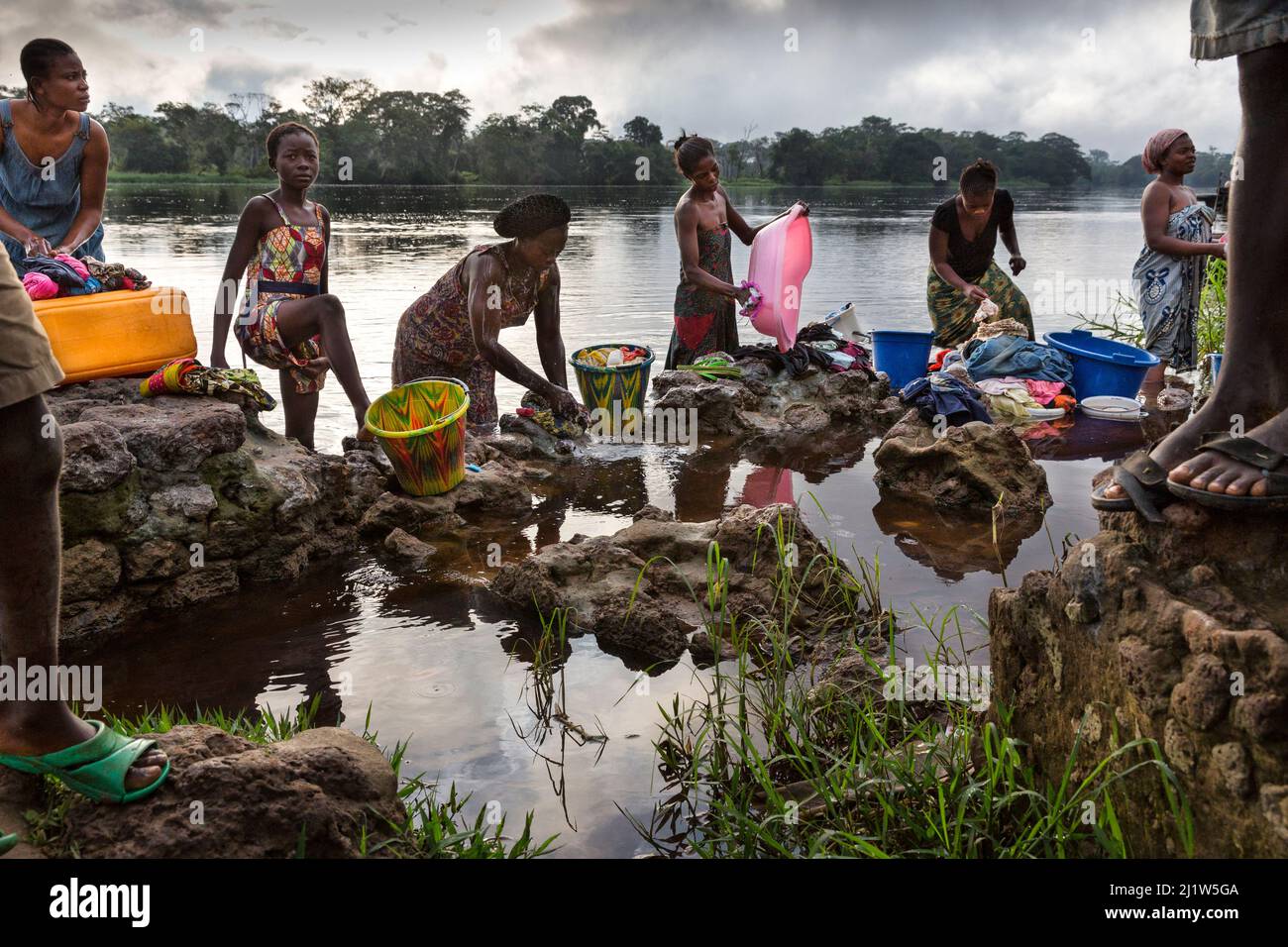 Local women washing clothes in river, Oshwe, Democratic Republic of the Congo. Stock Photohttps://www.alamy.com/image-license-details/?v=1https://www.alamy.com/local-women-washing-clothes-in-river-oshwe-democratic-republic-of-the-congo-image465847770.html
Local women washing clothes in river, Oshwe, Democratic Republic of the Congo. Stock Photohttps://www.alamy.com/image-license-details/?v=1https://www.alamy.com/local-women-washing-clothes-in-river-oshwe-democratic-republic-of-the-congo-image465847770.htmlRM2J1W5GA–Local women washing clothes in river, Oshwe, Democratic Republic of the Congo.
 Mangrove beds on the West side of Cat Island, Bahamas. Stock Photohttps://www.alamy.com/image-license-details/?v=1https://www.alamy.com/mangrove-beds-on-the-west-side-of-cat-island-bahamas-image612157509.html
Mangrove beds on the West side of Cat Island, Bahamas. Stock Photohttps://www.alamy.com/image-license-details/?v=1https://www.alamy.com/mangrove-beds-on-the-west-side-of-cat-island-bahamas-image612157509.htmlRM2XFX545–Mangrove beds on the West side of Cat Island, Bahamas.
 Portrait of scientist Nathan Cooper with telemetry device. Cat Island, Bahamas. Stock Photohttps://www.alamy.com/image-license-details/?v=1https://www.alamy.com/portrait-of-scientist-nathan-cooper-with-telemetry-device-cat-island-bahamas-image612157511.html
Portrait of scientist Nathan Cooper with telemetry device. Cat Island, Bahamas. Stock Photohttps://www.alamy.com/image-license-details/?v=1https://www.alamy.com/portrait-of-scientist-nathan-cooper-with-telemetry-device-cat-island-bahamas-image612157511.htmlRM2XFX547–Portrait of scientist Nathan Cooper with telemetry device. Cat Island, Bahamas.
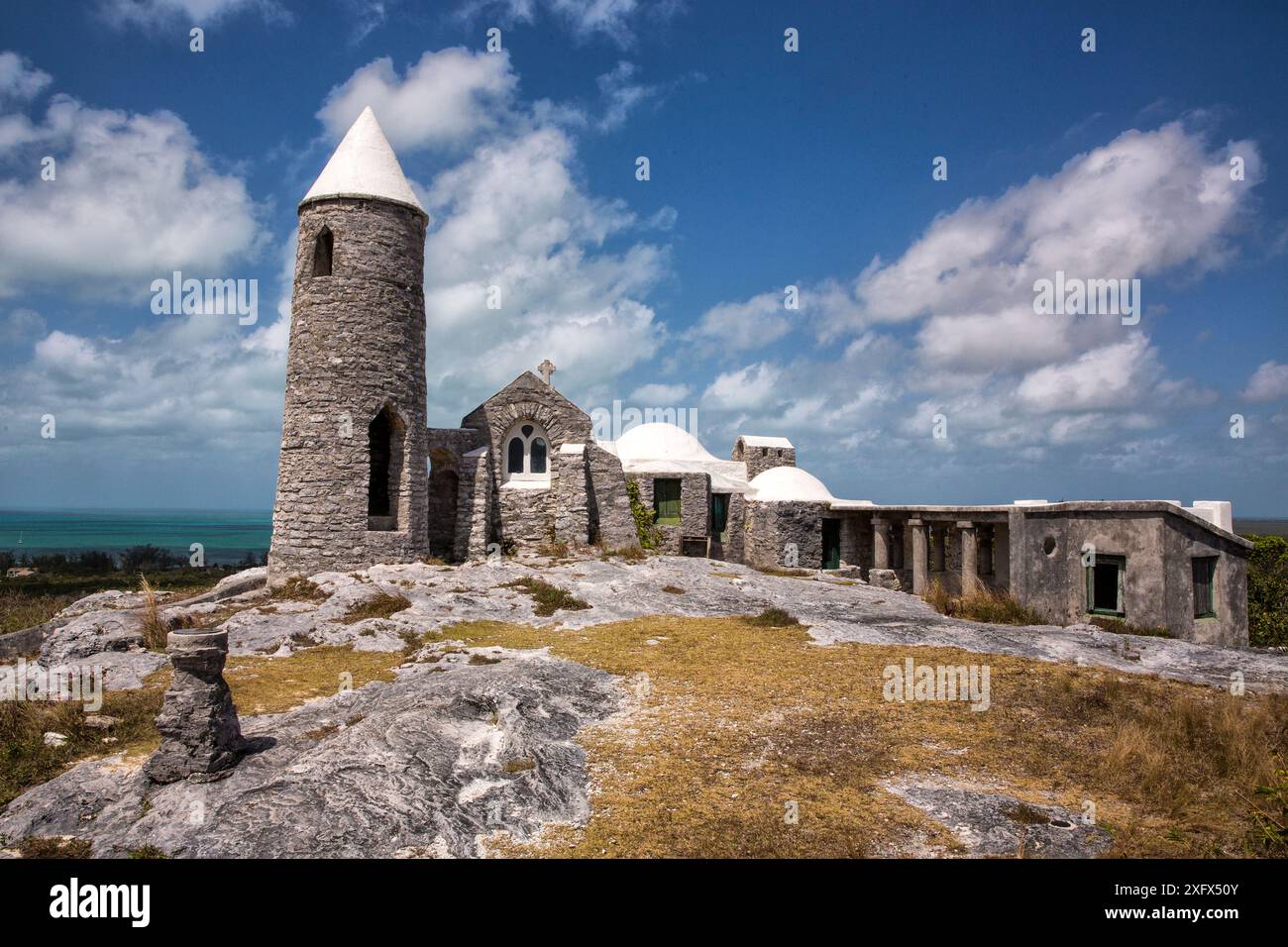 Hermitage on Mount Alvernia / Como Hill, the highest point in The Bahamas at 206 feet, Cat Island, Bahamas. Stock Photohttps://www.alamy.com/image-license-details/?v=1https://www.alamy.com/hermitage-on-mount-alvernia-como-hill-the-highest-point-in-the-bahamas-at-206-feet-cat-island-bahamas-image612157419.html
Hermitage on Mount Alvernia / Como Hill, the highest point in The Bahamas at 206 feet, Cat Island, Bahamas. Stock Photohttps://www.alamy.com/image-license-details/?v=1https://www.alamy.com/hermitage-on-mount-alvernia-como-hill-the-highest-point-in-the-bahamas-at-206-feet-cat-island-bahamas-image612157419.htmlRM2XFX50Y–Hermitage on Mount Alvernia / Como Hill, the highest point in The Bahamas at 206 feet, Cat Island, Bahamas.
 Scientists Stephen Caird and Chris Fox check the GPS waypoints where they know Kirkland's Warblers have been fitted with transmitters. They use telemetry to make sure the birds are still on the island. Cat Island, Bahamas. April 2017. Stock Photohttps://www.alamy.com/image-license-details/?v=1https://www.alamy.com/scientists-stephen-caird-and-chris-fox-check-the-gps-waypoints-where-they-know-kirkland39s-warblers-have-been-fitted-with-transmitters-they-use-telemetry-to-make-sure-the-birds-are-still-on-the-island-cat-island-bahamas-april-2017-image612157503.html
Scientists Stephen Caird and Chris Fox check the GPS waypoints where they know Kirkland's Warblers have been fitted with transmitters. They use telemetry to make sure the birds are still on the island. Cat Island, Bahamas. April 2017. Stock Photohttps://www.alamy.com/image-license-details/?v=1https://www.alamy.com/scientists-stephen-caird-and-chris-fox-check-the-gps-waypoints-where-they-know-kirkland39s-warblers-have-been-fitted-with-transmitters-they-use-telemetry-to-make-sure-the-birds-are-still-on-the-island-cat-island-bahamas-april-2017-image612157503.htmlRM2XFX53Y–Scientists Stephen Caird and Chris Fox check the GPS waypoints where they know Kirkland's Warblers have been fitted with transmitters. They use telemetry to make sure the birds are still on the island. Cat Island, Bahamas. April 2017.
 Scientist Nathan Cooper at the Smithsonian Migratory Bird Center holding Kirtland's warbler (Setophaga kirtlandii) during tagging study. CAt Island, Bahamas. April 2017. Stock Photohttps://www.alamy.com/image-license-details/?v=1https://www.alamy.com/scientist-nathan-cooper-at-the-smithsonian-migratory-bird-center-holding-kirtland39s-warbler-setophaga-kirtlandii-during-tagging-study-cat-island-bahamas-april-2017-image612157404.html
Scientist Nathan Cooper at the Smithsonian Migratory Bird Center holding Kirtland's warbler (Setophaga kirtlandii) during tagging study. CAt Island, Bahamas. April 2017. Stock Photohttps://www.alamy.com/image-license-details/?v=1https://www.alamy.com/scientist-nathan-cooper-at-the-smithsonian-migratory-bird-center-holding-kirtland39s-warbler-setophaga-kirtlandii-during-tagging-study-cat-island-bahamas-april-2017-image612157404.htmlRM2XFX50C–Scientist Nathan Cooper at the Smithsonian Migratory Bird Center holding Kirtland's warbler (Setophaga kirtlandii) during tagging study. CAt Island, Bahamas. April 2017.
 Blood sample collecting from Kirkland's warblers (Setophaga kirtlandii) Cat Island, Bahamas. April 2017. Stock Photohttps://www.alamy.com/image-license-details/?v=1https://www.alamy.com/blood-sample-collecting-from-kirkland39s-warblers-setophaga-kirtlandii-cat-island-bahamas-april-2017-image612157405.html
Blood sample collecting from Kirkland's warblers (Setophaga kirtlandii) Cat Island, Bahamas. April 2017. Stock Photohttps://www.alamy.com/image-license-details/?v=1https://www.alamy.com/blood-sample-collecting-from-kirkland39s-warblers-setophaga-kirtlandii-cat-island-bahamas-april-2017-image612157405.htmlRM2XFX50D–Blood sample collecting from Kirkland's warblers (Setophaga kirtlandii) Cat Island, Bahamas. April 2017.
 Smooth-billed ani (Crotophaga ani) Cat Island, Bahamas Stock Photohttps://www.alamy.com/image-license-details/?v=1https://www.alamy.com/smooth-billed-ani-crotophaga-ani-cat-island-bahamas-image612157592.html
Smooth-billed ani (Crotophaga ani) Cat Island, Bahamas Stock Photohttps://www.alamy.com/image-license-details/?v=1https://www.alamy.com/smooth-billed-ani-crotophaga-ani-cat-island-bahamas-image612157592.htmlRM2XFX574–Smooth-billed ani (Crotophaga ani) Cat Island, Bahamas
 Scientist Nathan Cooper detangles and endangered Kirtland's Warbler (Setophaga kirtlandii) from the mist net. This bird was caught for tagging during research into migration and behaviour. Cat Island, Bahamas. April 2017. Stock Photohttps://www.alamy.com/image-license-details/?v=1https://www.alamy.com/scientist-nathan-cooper-detangles-and-endangered-kirtland39s-warbler-setophaga-kirtlandii-from-the-mist-net-this-bird-was-caught-for-tagging-during-research-into-migration-and-behaviour-cat-island-bahamas-april-2017-image612157334.html
Scientist Nathan Cooper detangles and endangered Kirtland's Warbler (Setophaga kirtlandii) from the mist net. This bird was caught for tagging during research into migration and behaviour. Cat Island, Bahamas. April 2017. Stock Photohttps://www.alamy.com/image-license-details/?v=1https://www.alamy.com/scientist-nathan-cooper-detangles-and-endangered-kirtland39s-warbler-setophaga-kirtlandii-from-the-mist-net-this-bird-was-caught-for-tagging-during-research-into-migration-and-behaviour-cat-island-bahamas-april-2017-image612157334.htmlRM2XFX4WX–Scientist Nathan Cooper detangles and endangered Kirtland's Warbler (Setophaga kirtlandii) from the mist net. This bird was caught for tagging during research into migration and behaviour. Cat Island, Bahamas. April 2017.
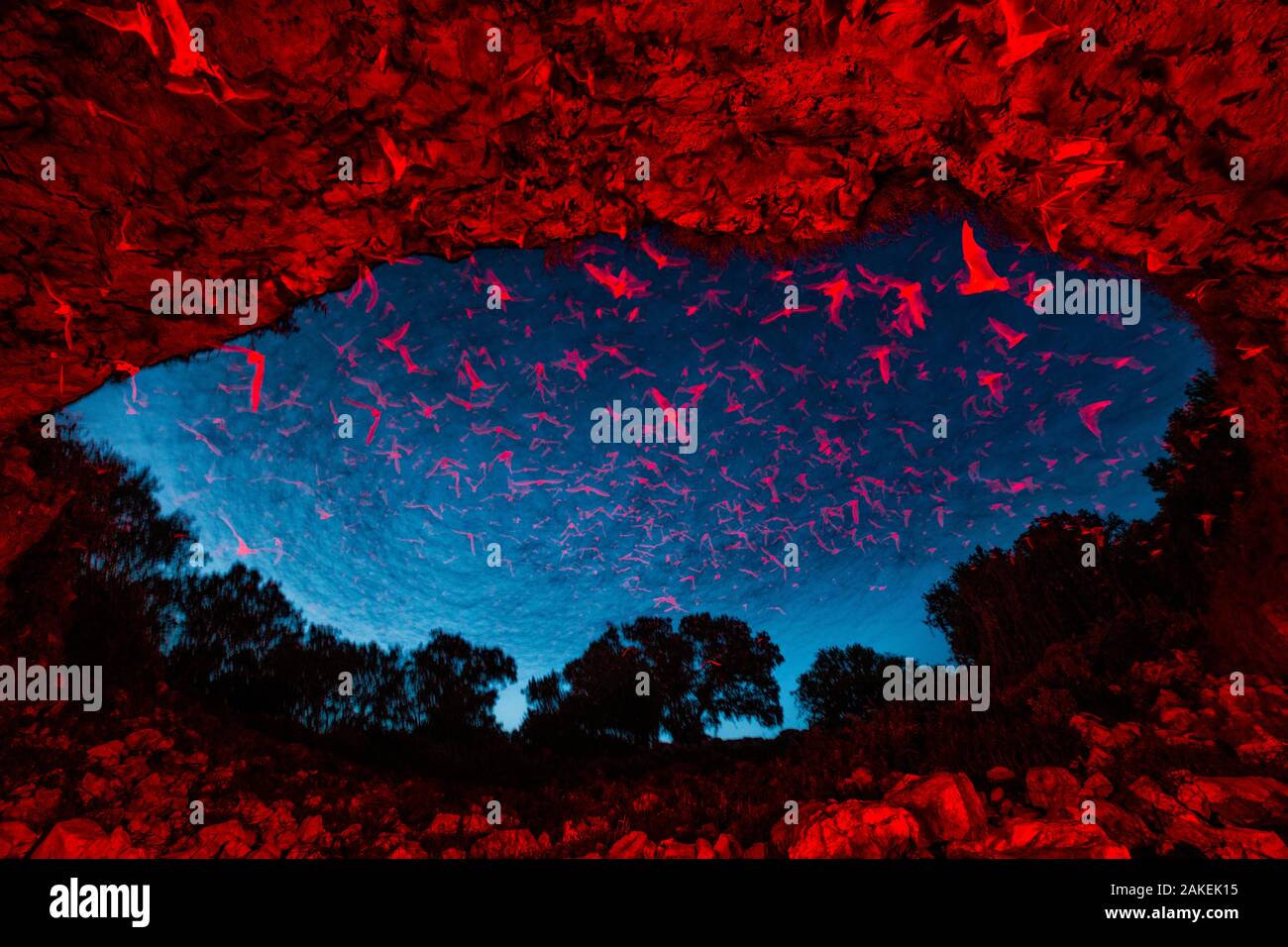 Mexican free-tailed bats (Tadarida brasiliensis) leaving maternity colony at night to feed, with red lighting at entrance to cave. Bracken Cave, San Antonio, Texas, USA, July. Bracken Cave is the world's largest bat maternity colony. Stock Photohttps://www.alamy.com/image-license-details/?v=1https://www.alamy.com/mexican-free-tailed-bats-tadarida-brasiliensis-leaving-maternity-colony-at-night-to-feed-with-red-lighting-at-entrance-to-cave-bracken-cave-san-antonio-texas-usa-july-bracken-cave-is-the-worlds-largest-bat-maternity-colony-image338997713.html
Mexican free-tailed bats (Tadarida brasiliensis) leaving maternity colony at night to feed, with red lighting at entrance to cave. Bracken Cave, San Antonio, Texas, USA, July. Bracken Cave is the world's largest bat maternity colony. Stock Photohttps://www.alamy.com/image-license-details/?v=1https://www.alamy.com/mexican-free-tailed-bats-tadarida-brasiliensis-leaving-maternity-colony-at-night-to-feed-with-red-lighting-at-entrance-to-cave-bracken-cave-san-antonio-texas-usa-july-bracken-cave-is-the-worlds-largest-bat-maternity-colony-image338997713.htmlRM2AKEK15–Mexican free-tailed bats (Tadarida brasiliensis) leaving maternity colony at night to feed, with red lighting at entrance to cave. Bracken Cave, San Antonio, Texas, USA, July. Bracken Cave is the world's largest bat maternity colony.